Outdoor kitchens have evolved into true three-season living spaces, and the roof you place overhead now does far more than block sun. Designers are blending traditional pavilions with high-tech pergolas, energy-harvesting solar canopies, and even living roofs so cooks stay dry, appliances stay protected, and patios feel like extensions of the house. Recent round-ups from Bob Vila, The Spruce, Real Simple, and industry specialists all stress flexible shade, durable materials, and integrated lighting as must-haves for 2025 backyard projects.
1. Gabled Wooden Pavilion Roof Adds Architectural Presence
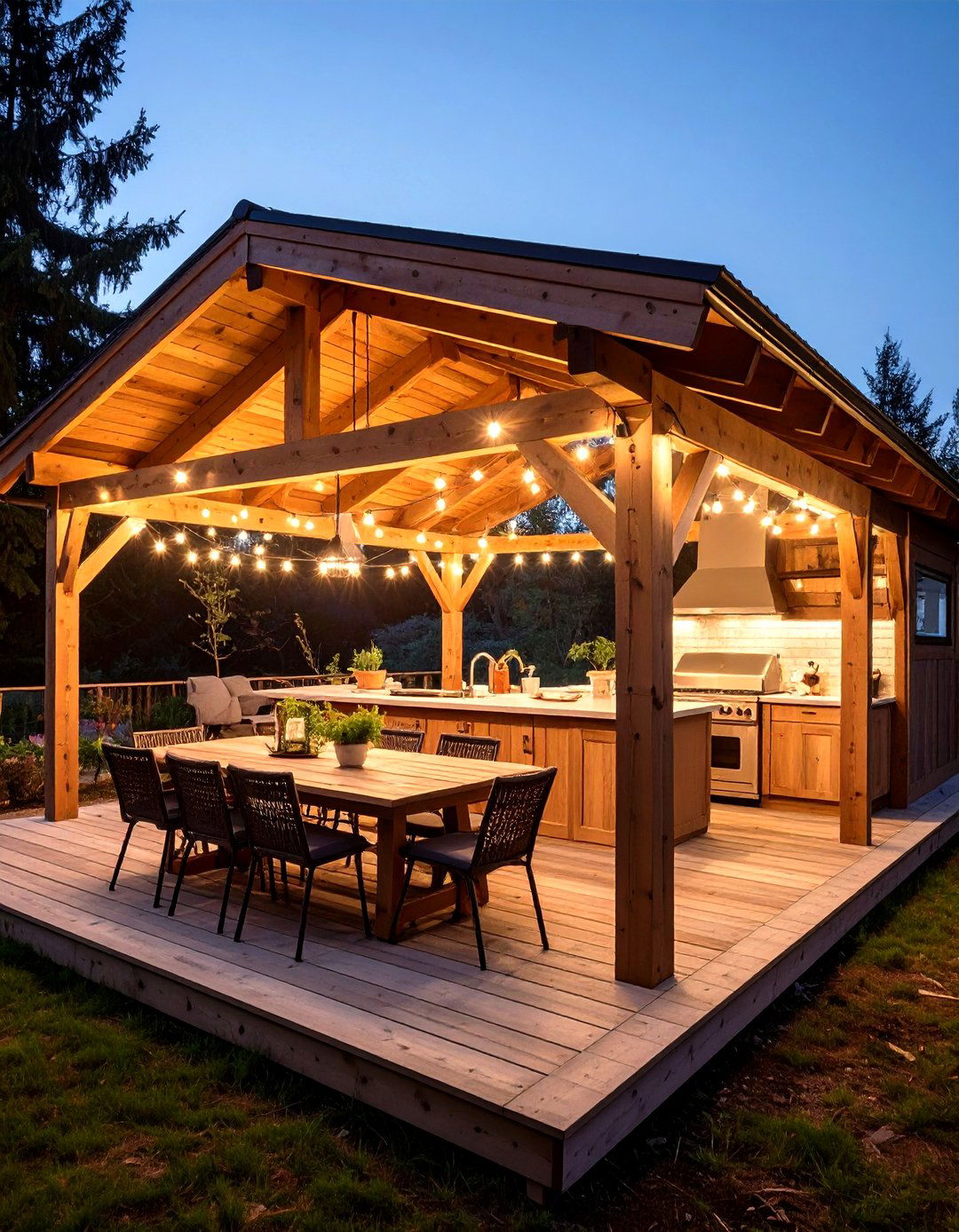
A classic gabled pavilion roof built from pressure-treated pine echoes farmhouse porches yet scales beautifully for stainless gas grills and pizza ovens. The pitched shape sheds rain and snow fast, while exposed rafters invite pendant heaters or festoon lights for evening gatherings. Because loads transfer to posts at the perimeter, counters stay wall-free and traffic flows easily around prep zones. Order-from-factory kits arrive pre-cut and pre-drilled, trimming labor if you’re handy with a wrench, and the natural wood can be stained to match decking or left to silver gracefully.
2. Slim Modern Flat Roof With Recessed LED Glow
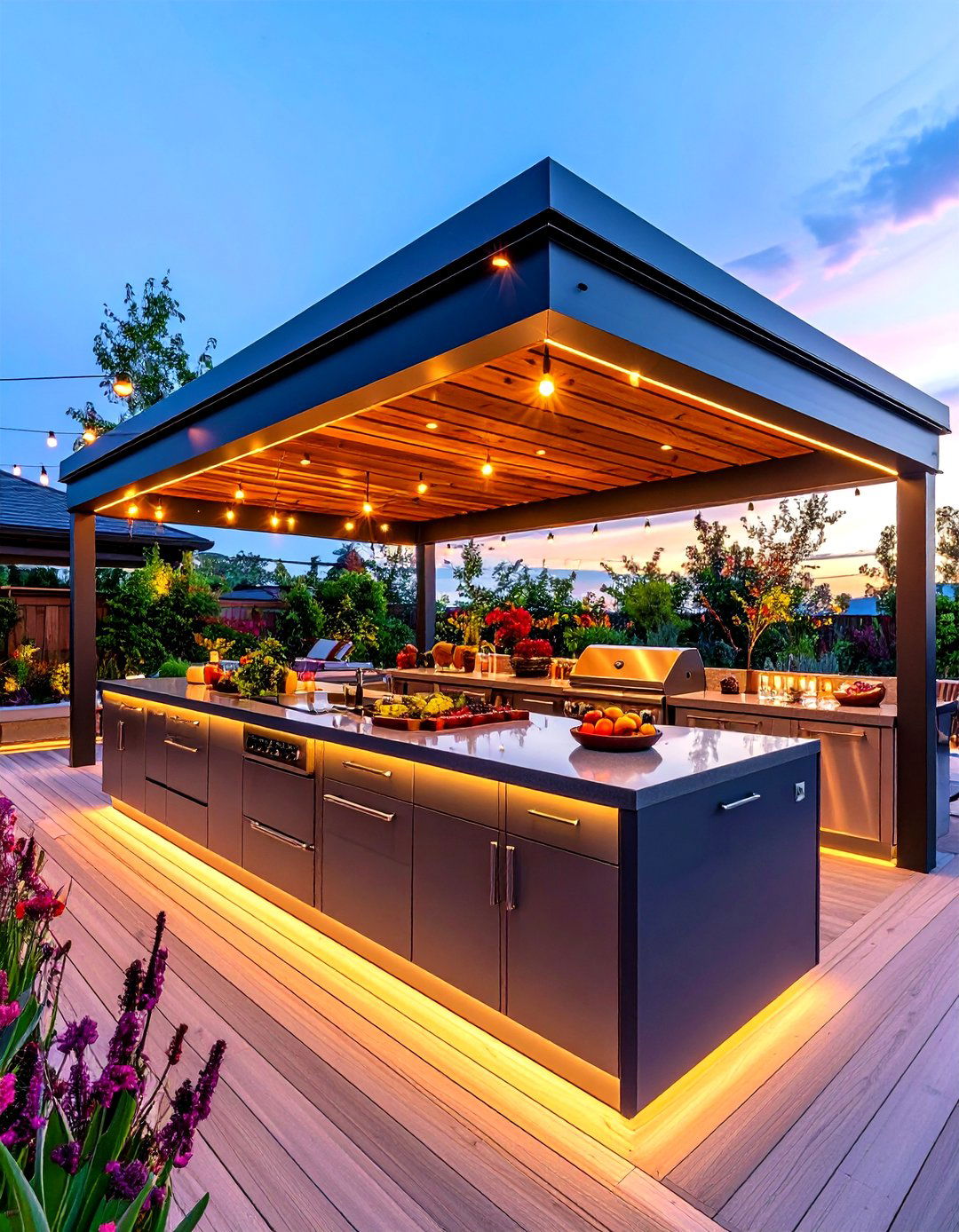
For homes with strong contemporary lines, a flat outdoor kitchen roof in powder-coated aluminum delivers the same crisp profile as interior ceilings. Recessed or strip LEDs tucked between panels bathe countertops in task light and double as subtle mood lighting after dark. Designers like Marie Flanigan highlight how a wafer-thin canopy creates uninterrupted sightlines to the garden while hiding wiring in integrated channels. Choose insulated sandwich panels to mute rain noise and deflect midday heat, then angle a concealed gutter toward a downspout so runoff never splashes guests.
3. Classic Pergola Roof Dressed in Climbing Vines
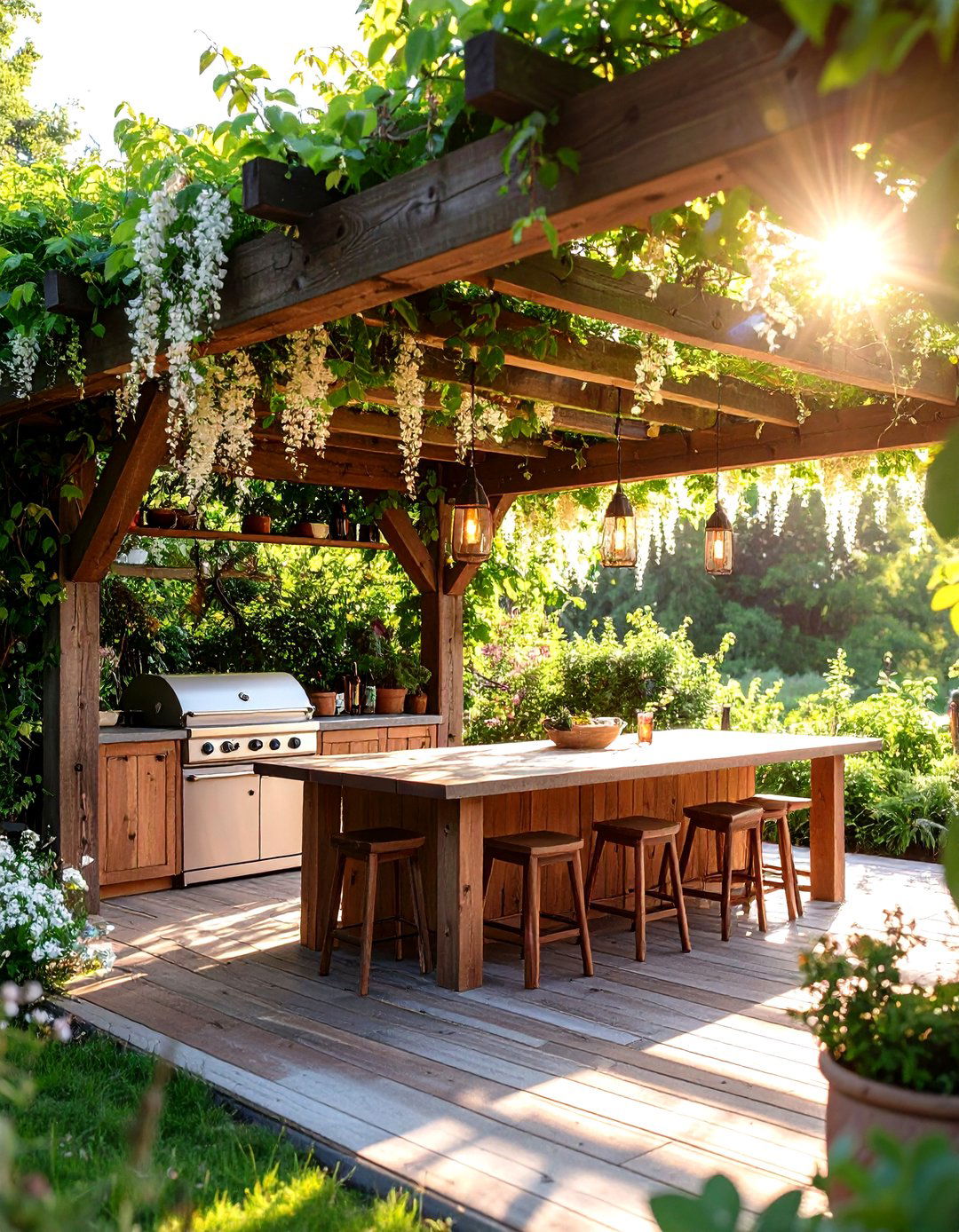
A timber pergola roof offers partial shade and an irresistible canvas for jasmine, grapes, or wisteria to weave overhead. Better Homes & Gardens notes that living canopies drop radiant temperatures up to 10 °F and perfume the entire cooking zone each bloom cycle. When winter arrives, deciduous vines shed leaves, letting welcome sunlight reach smokers and prep sinks. Be sure to size beams for eventual plant weight and pick rot-resistant cedar or pressure-treated pine. A quick mist with a hose keeps foliage dust-free and herbs beneath extra happy.
4. Motorized Louvered Aluminum Roof Gives Weather-on-Demand
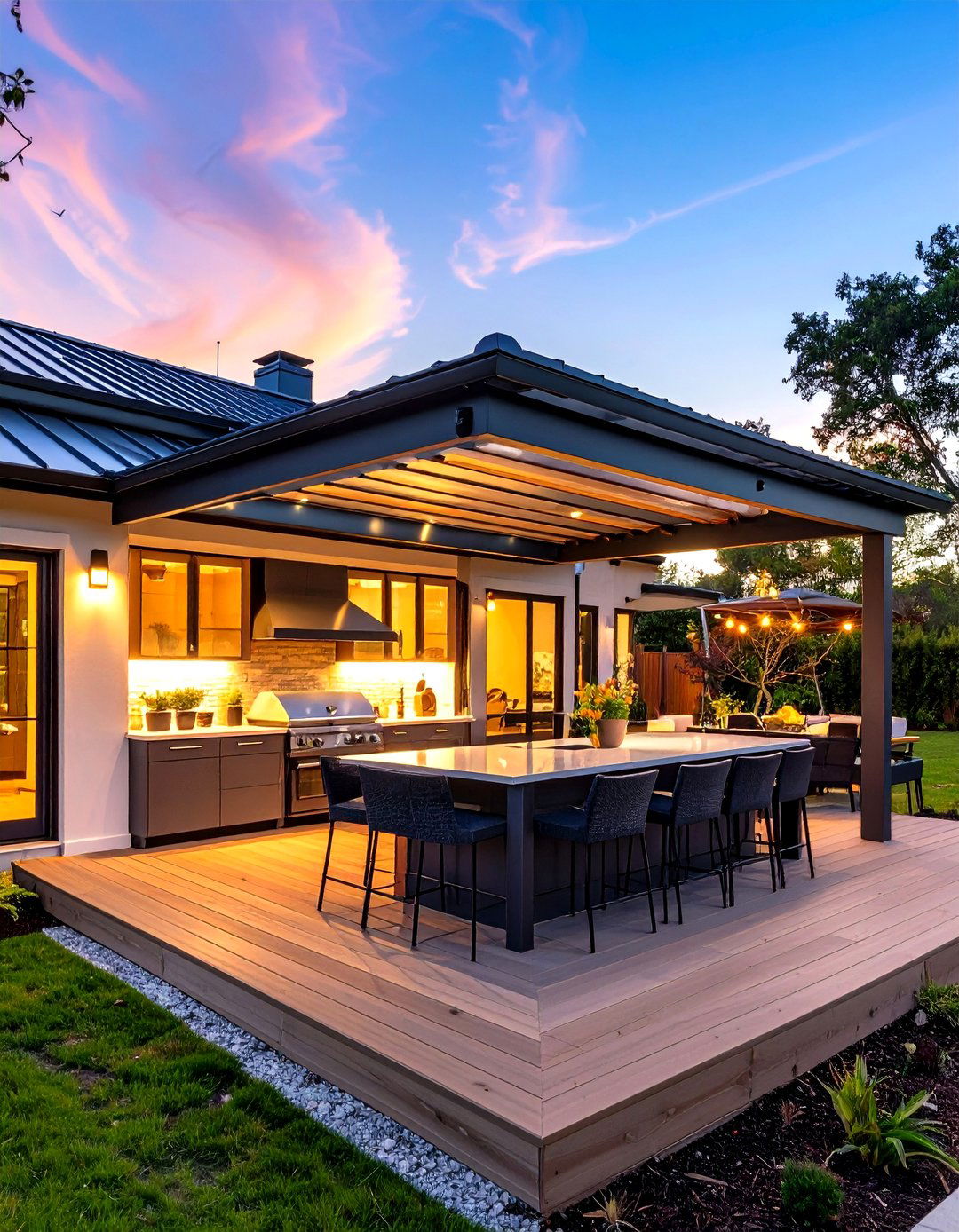
Touch a remote and angled louvers pivot from full sun to watertight shelter in under a minute — ideal when steaks and an unexpected shower arrive simultaneously. StruXure and Apollo both boast interlocking blades that drain into hidden gutters, so countertops stay bone-dry without bulky rafters. Adjustable slats also funnel breezes toward the grill master or seal heat on cool nights, extending the usable season by weeks. Powder-coated aluminum resists rust, and integrated sensors can close the roof automatically at the first hint of rain.
5. Mediterranean Clay-Tile Roof Blends Seamlessly With the House
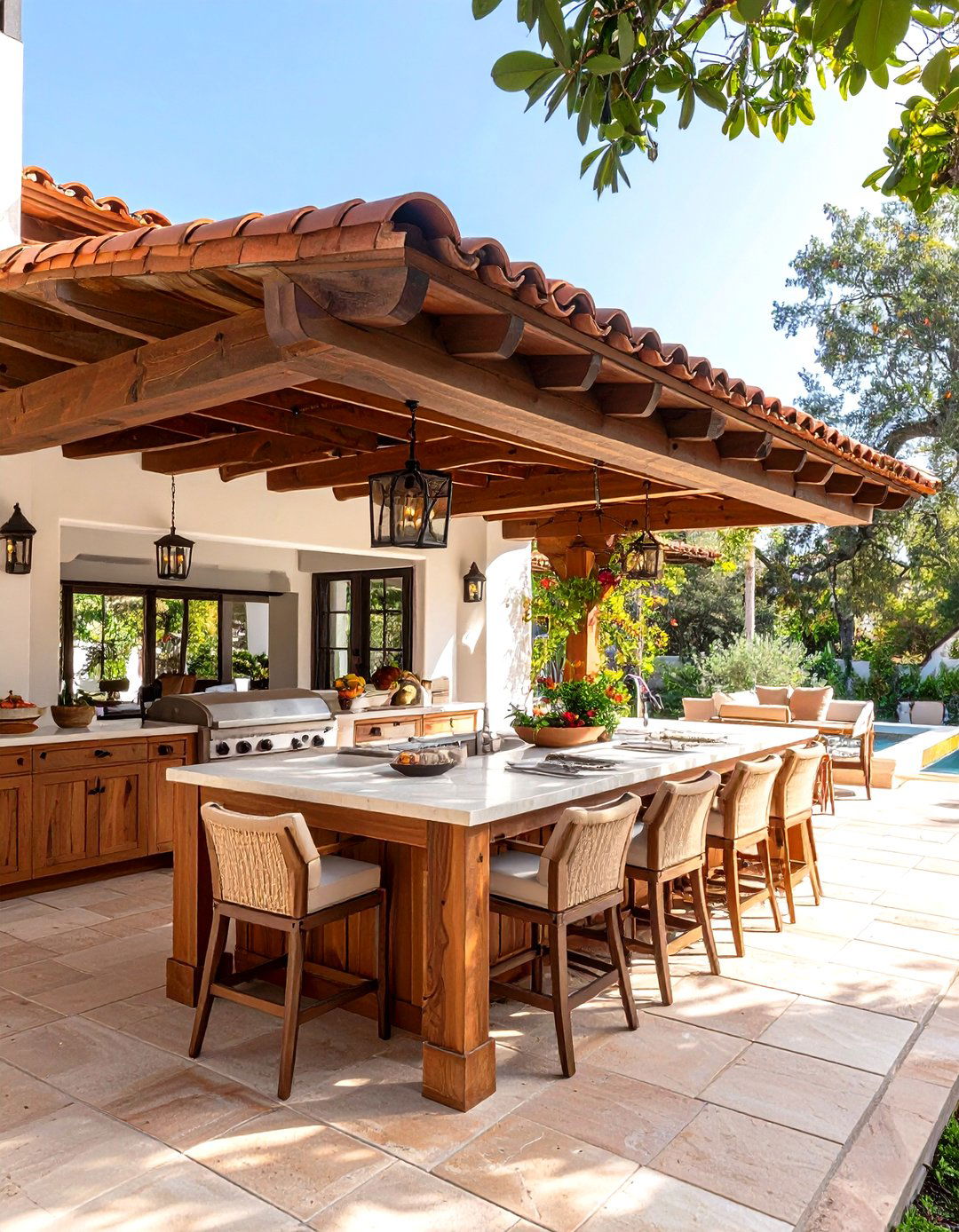
If your primary residence features terracotta tiles, repeating that material over the outdoor kitchen unifies facades and boosts resale value. HGTV spotlights projects where a clay-tile shed roof paired with cedar fascia keeps smoke out of eaves yet echoes the home’s warm palette. Tiles’ thermal mass dampens midday heat, protecting refrigerators from compressor fatigue, while the Class A fire rating adds peace of mind beside open-flame cooktops. Combine with stucco columns for an authentic Spanish-revival vibe.
6. Corrugated Metal Lean-To Roof for Industrial Edge
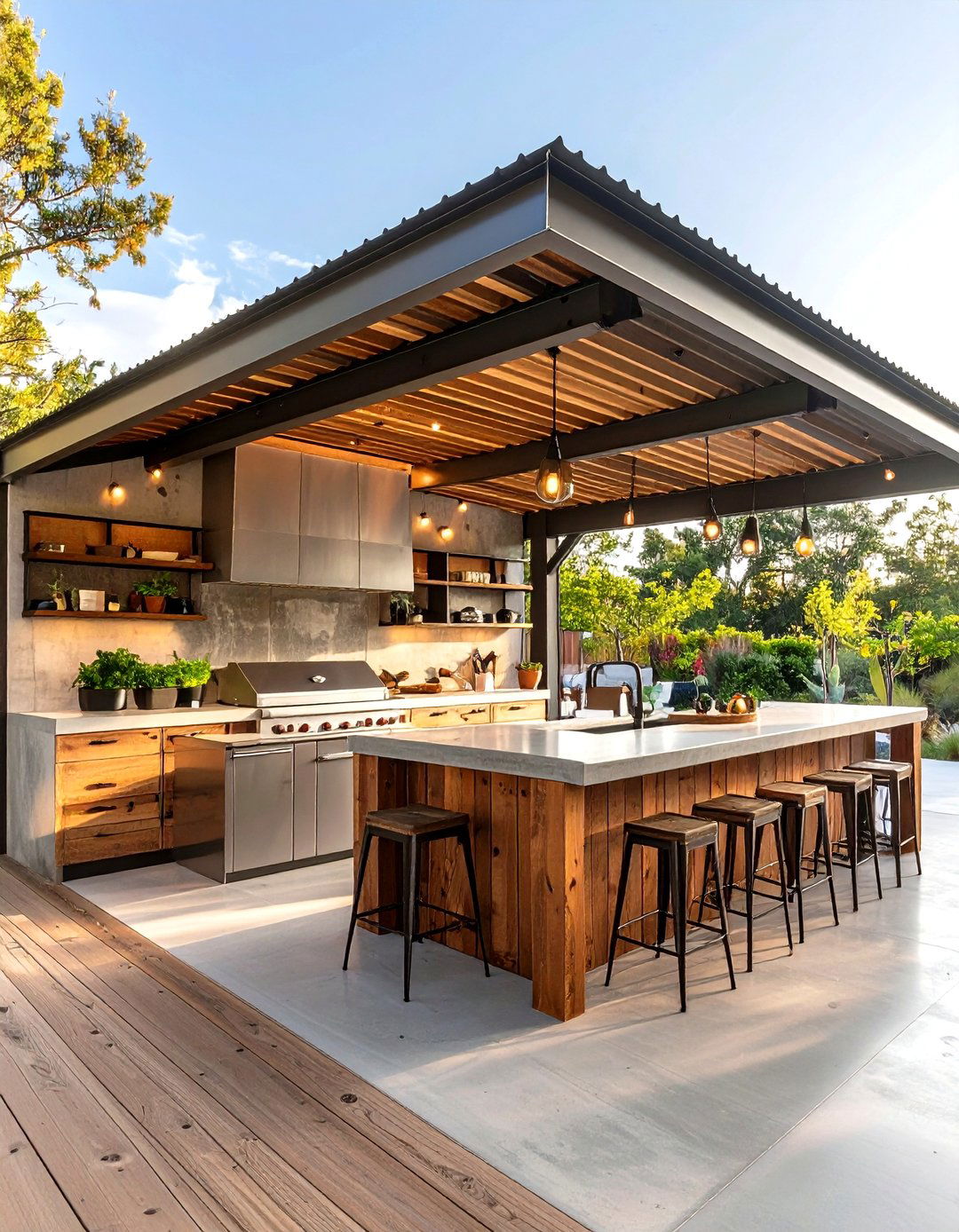
Corrugated steel or aluminum sheets screwed to a shallow-pitched frame create an affordable, nearly indestructible cover that pairs perfectly with concrete counters and reclaimed-wood bars. Bob Vila points out that modern coatings reflect up to 25 percent more solar heat than shingles, lowering ambient temps around the grill. Sound a little tinny? Add a thin layer of sheathing beneath to hush rainfall without losing the raw, workshop aesthetic homeowners crave. Bonus: panels are light enough for DIYers to install over a weekend.
7. Transparent Polycarbonate Roof Floods Prep Zones With Light
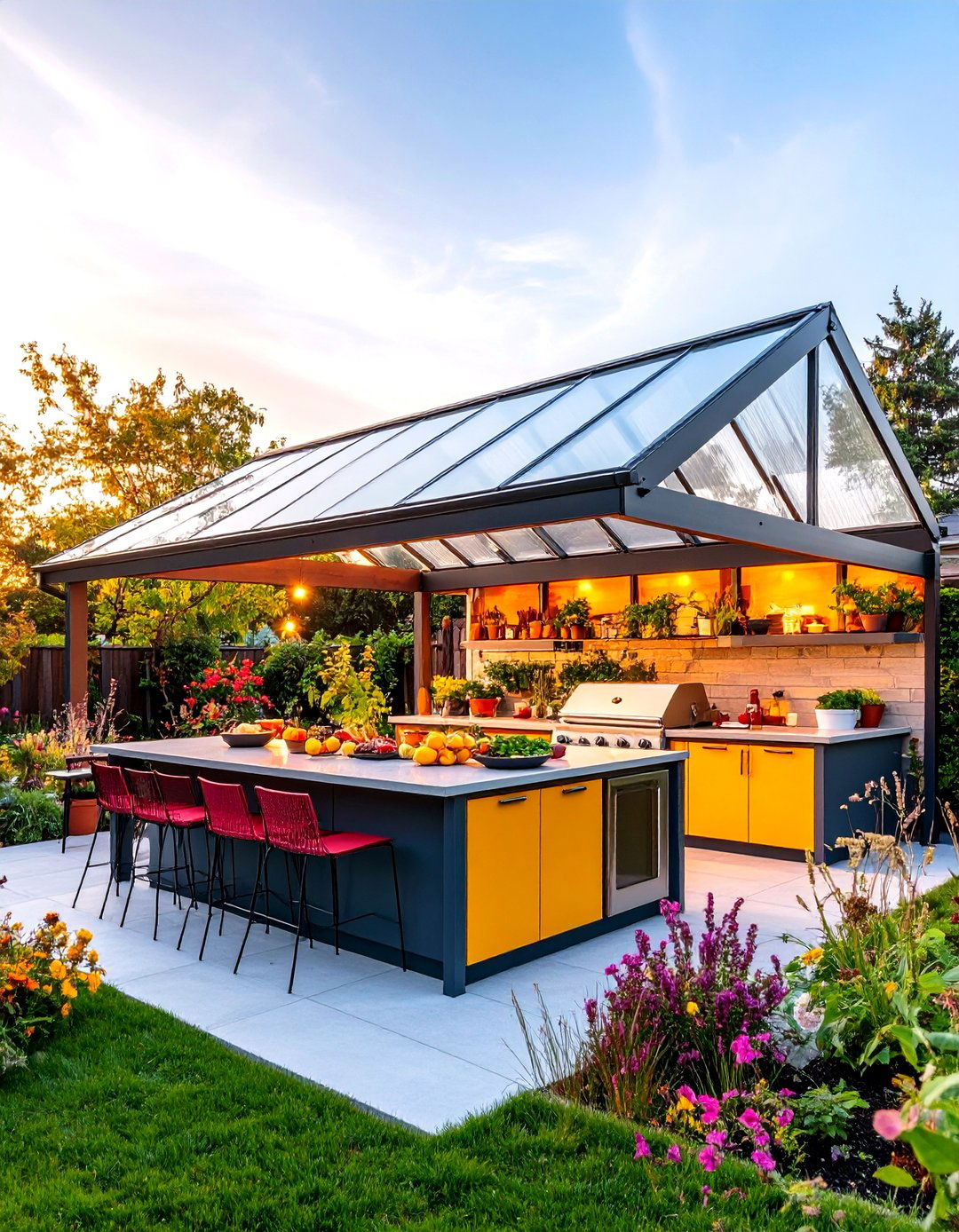
Chefs who value bright, shadow-free chopping areas can swap opaque panels for UV-protected polycarbonate sheets. The material weighs far less than glass yet blocks 99 percent of harmful rays, so cutting boards and resin wicker won’t fade. Clear spans up to 12 feet reduce the need for intermediate rafters, creating an airy pavilion feel. Be sure to choose a multi-wall panel for higher insulation where frosts are common, and allow a slight pitch to shed condensation.
8. Solar-Panel Roof Generates Power While You Grill

Why not let the roof offset the fridge’s wattage? Azenco’s solar pergola integrates bifacial panels that still harvest energy from underside reflections, making the structure a silent, shade-giving micro-utility. Wiring tucks inside hollow beams and feeds a wall inverter, so you can run task lights, rotisserie motors, or even charge an electric smoker without drawing from the grid. Panels also act as hard-shingle roofs, channeling rainwater to a concealed gutter.
9. Thatched Palapa Roof Creates Instant Tropical Escape
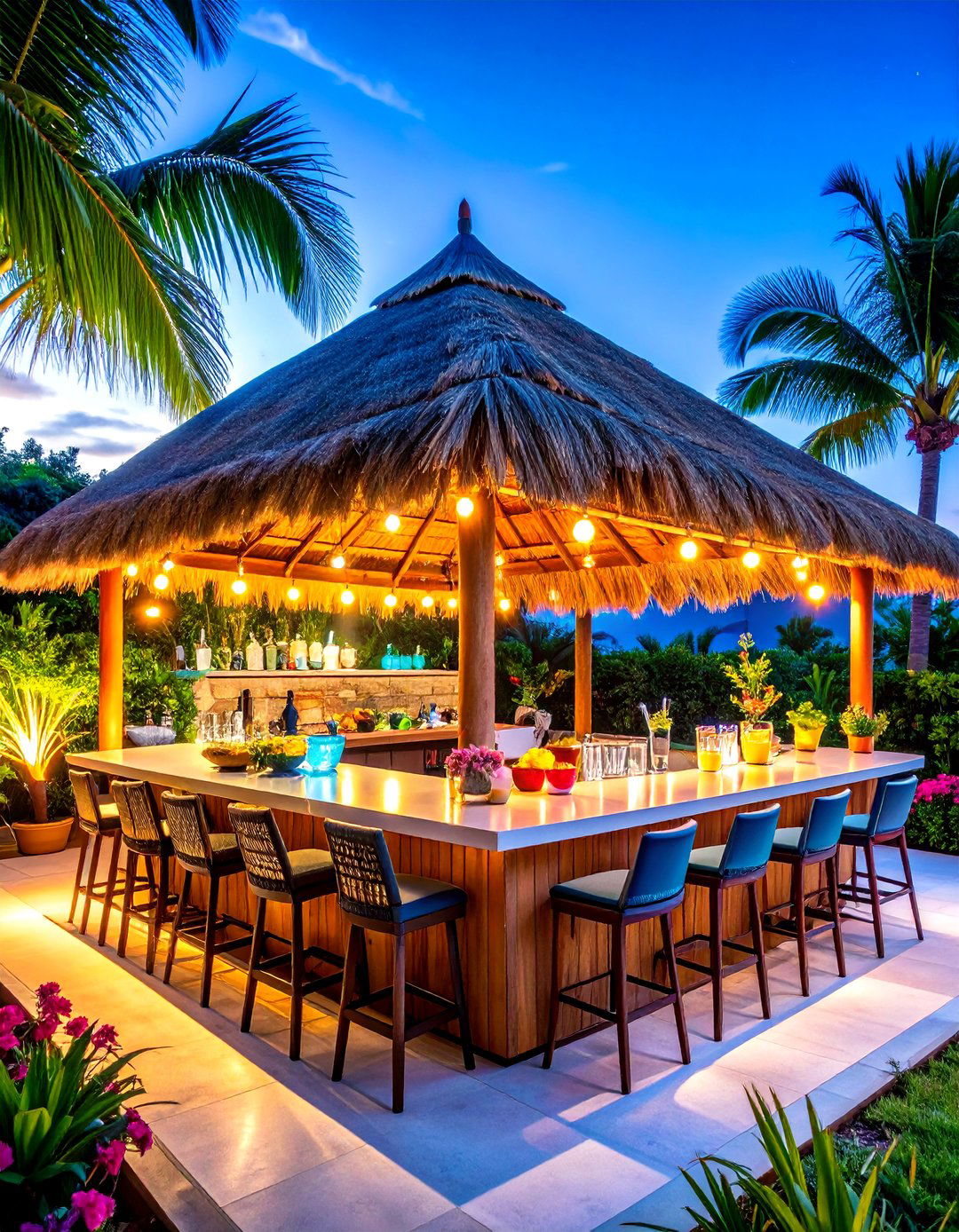
A hand-tied thatch or palm-leaf palapa offers unbeatable island ambiance and surprisingly good insulation — design pros say the thick organic layers can drop rooftop temperatures by double digits on blistering afternoons. Houzz contributors add that modern fire-retardant coatings extend lifespan past 20 years when properly installed. Pair with a built-in margarita bar and bamboo detailing for resort-level escapism in the suburbs.
10. Retractable Fabric Awning Roof Slides Away for Stargazing
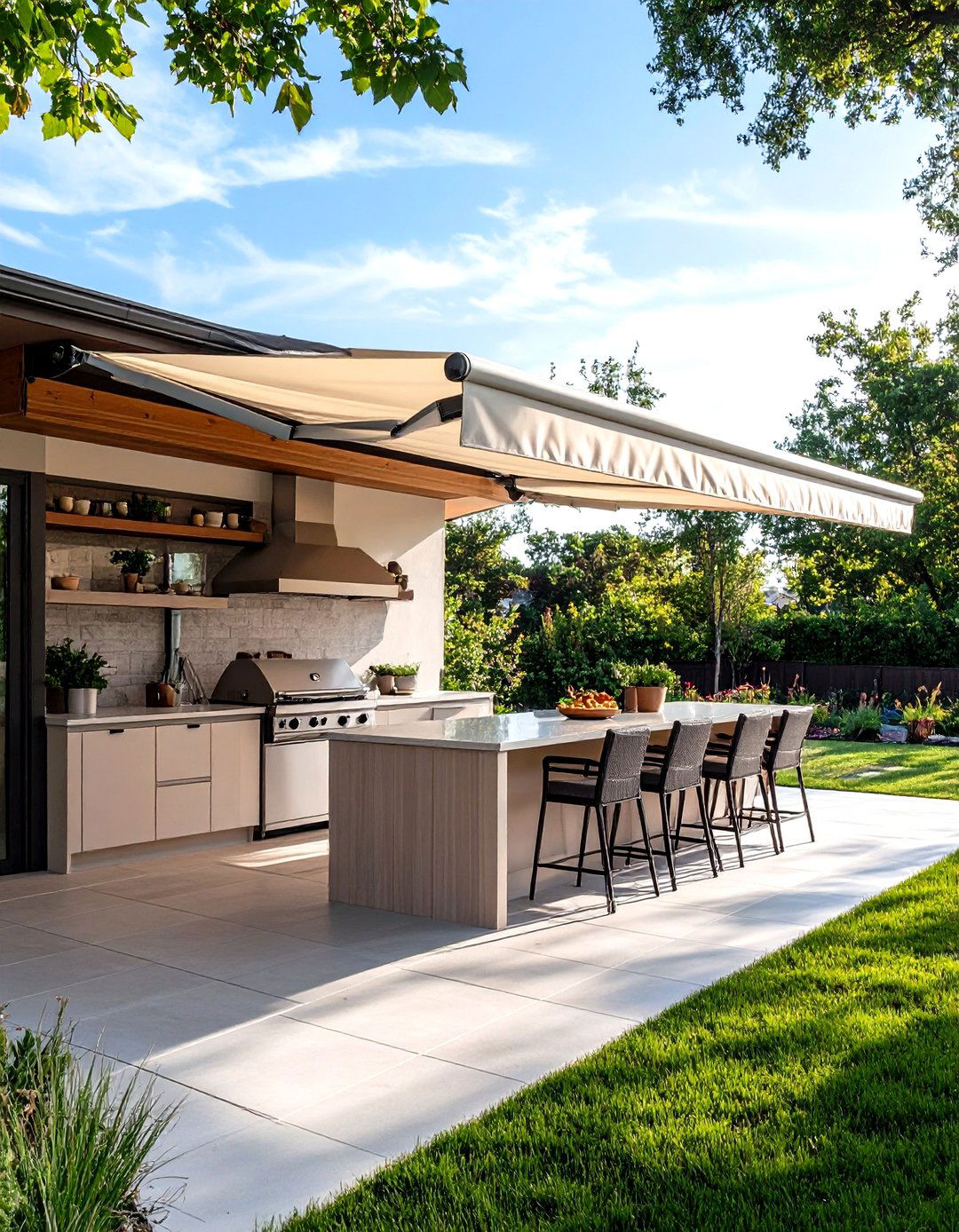
Motorized fabric roofs ride slim tracks and concertina at one end, exposing the night sky within seconds. BTX explains that waterproof, UV-stable textiles now span up to 30 feet, so even a full outdoor kitchen island can tuck beneath. Close the canopy midday to protect delicate ingredients, then retract at dusk for smoke to float freely. Optional wind sensors safeguard the mechanism by auto-closing during gusty storms.
11. Slatted Cedar Shade Roof Balances Light and Shadow
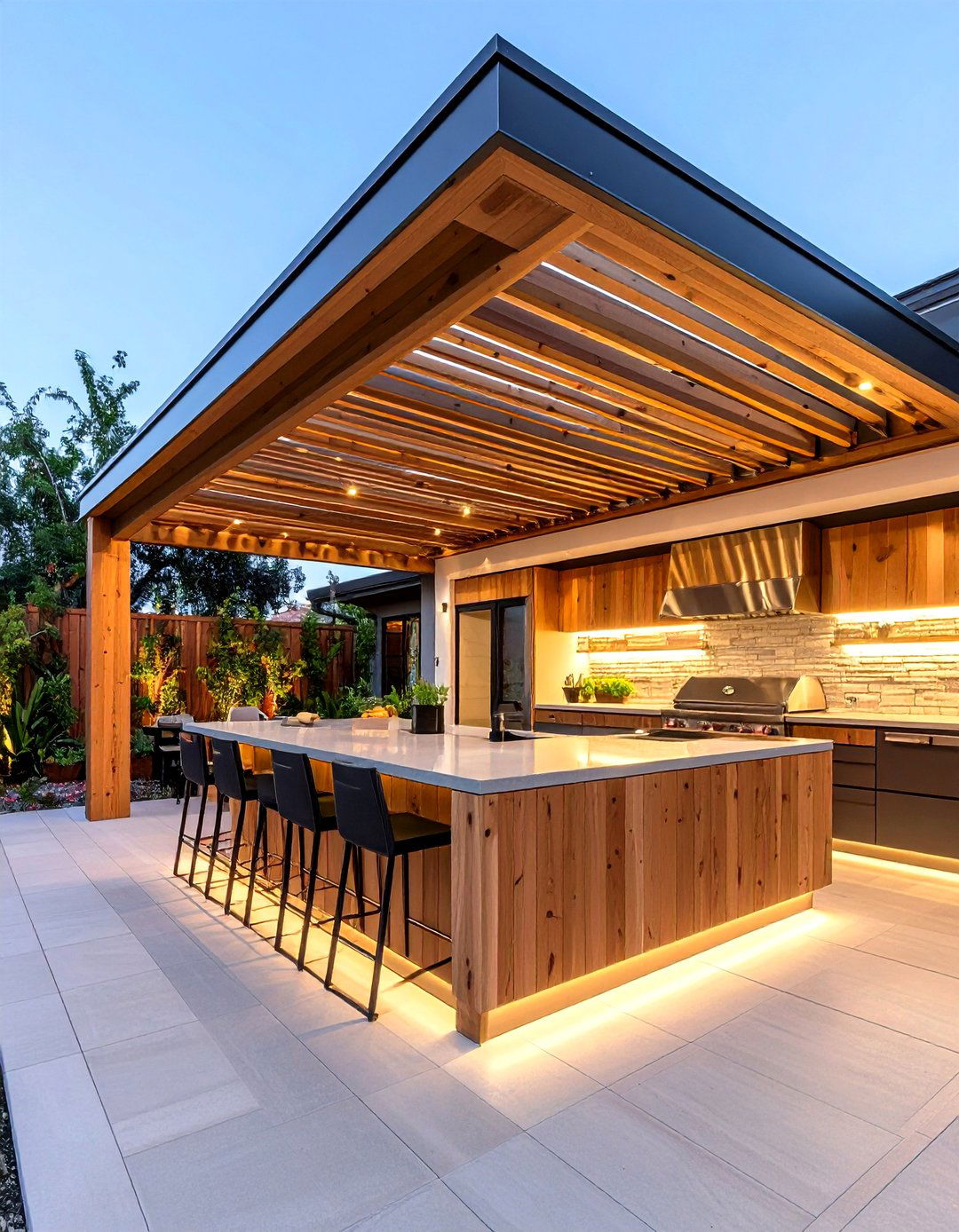
A rhythm of 2-inch cedar slats spaced an inch apart breaks harsh glare while still letting wisps of grill smoke escape. Real Simple’s shade guide credits the pattern for creating painterly stripes of sunlight that feel cooler than an open patio yet never claustrophobic. Cedar’s natural tannins resist insects and gray gracefully, so maintenance rarely exceeds an annual rinse and oil. Thread LED tape along the underside for a lantern-like glow after sunset.
12. Green Living Roof Grows Herbs Above the Pizza Oven

Extensive green roofs — just four inches of lightweight soil — support low-growing sedums and even culinary thyme or oregano, keeping pizza toppings within arm’s reach. UK landscapers at Hollandscapes note that plant evapotranspiration cools spaces below, a perk for guests sitting near a sizzling grill. Be sure the frame is engineered for the extra saturated weight and install a waterproof EPDM liner before adding drainage mats and soil.
13. Shade-Sail Trio Roof for Playful Geometry
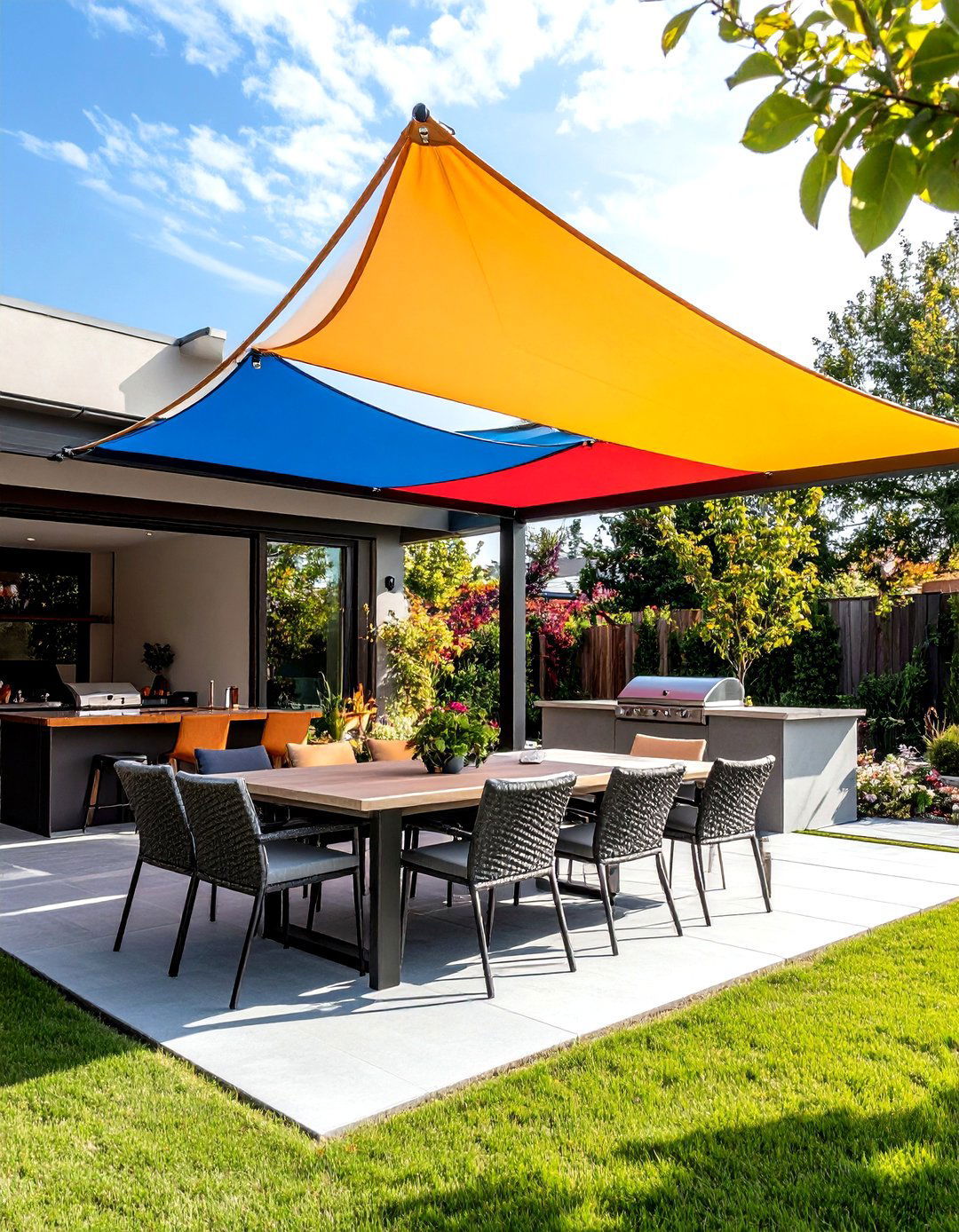
Anchoring three overlapping HDPE shade sails at varied heights creates a sculptural, color-blocked roof that moves with the breeze. Manufacturers like Maanta tout up-to-98 percent UV blockage plus breathable weave that prevents smoke buildup. Stainless turnbuckles let you tension fabric drum-tight so rain runs off the low corner and doesn’t puddle. Swap hues seasonally for an instant style refresh without touching the frame.
14. Barrel-Vault Metal Roof Channels Runoff Dramatically
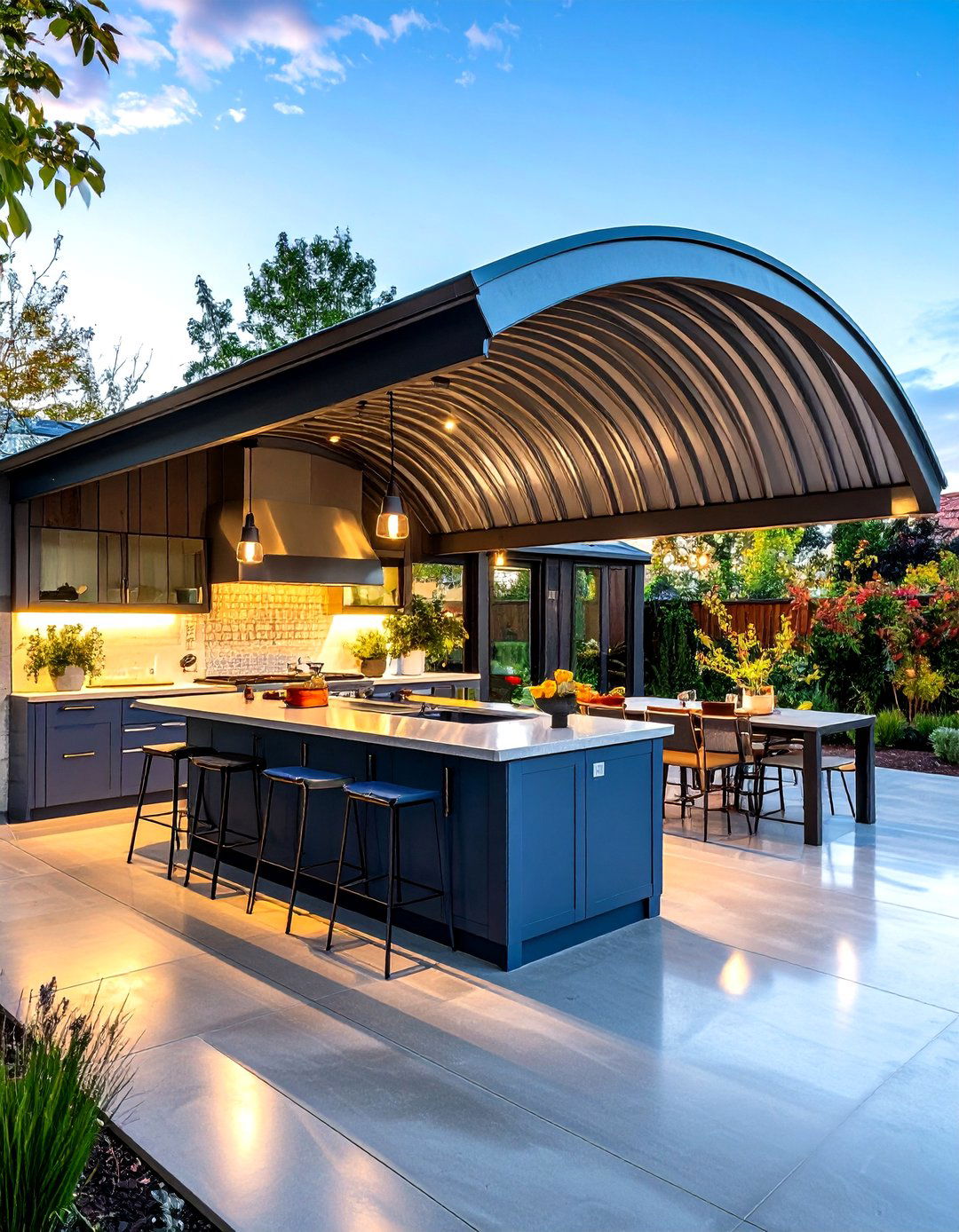
Curving lightweight aluminum ribs into a half-cylinder gives the outdoor kitchen a pavilion aura while ensuring water cascades quickly to integrated gutters. Tensile-fabric specialists explain that the arched shape tolerates higher snow loads than flat pergolas and sheds debris efficiently. Pair the silvery finish with polished concrete floors for a sleek, almost aviation-inspired aesthetic.
15. Rustic Timber Frame With Corrugated Tin Roof
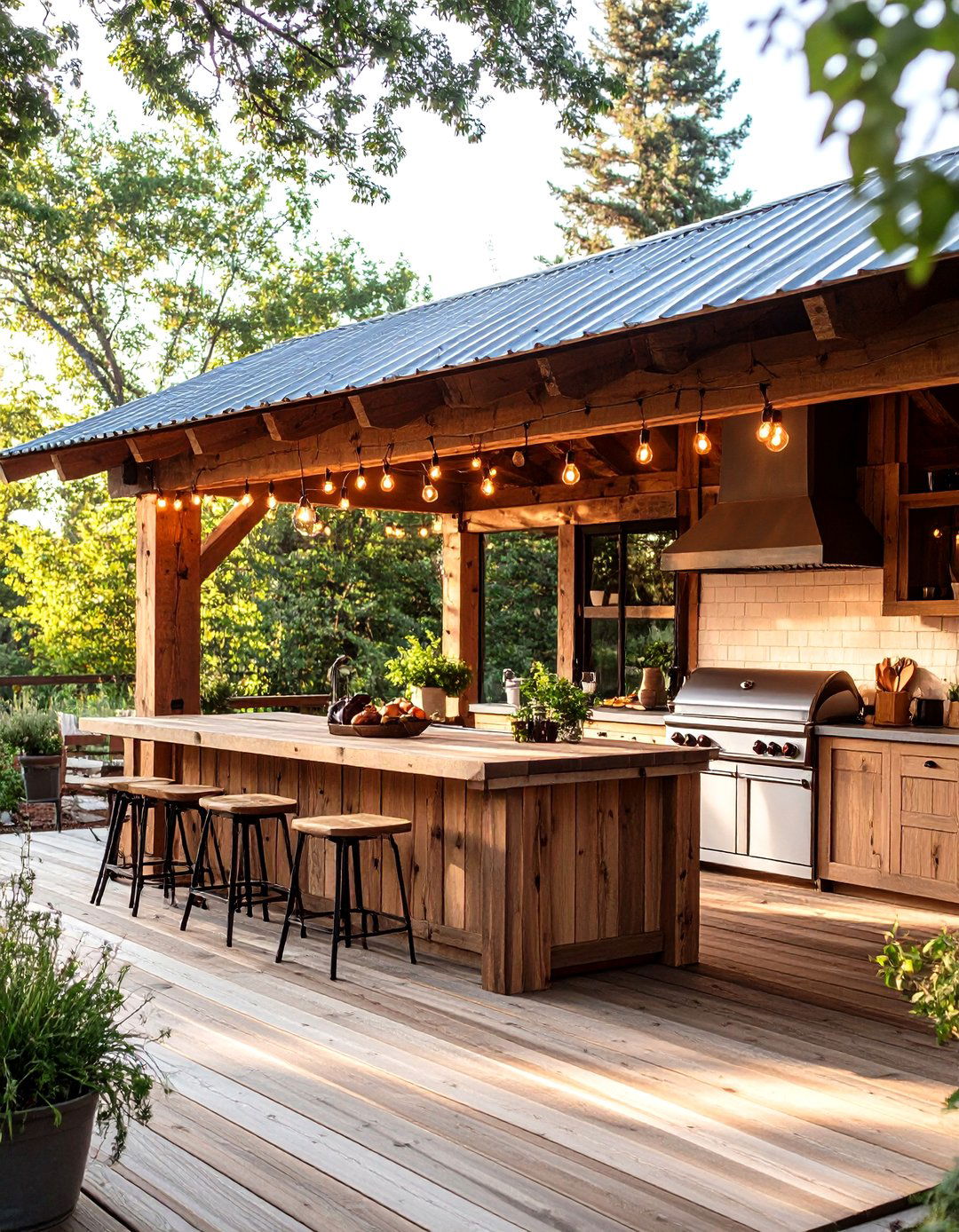
Blend a lodge vibe into the backyard by topping chunky reclaimed beams with weathered galvanized tin. Bob Vila’s metal-roof primers highlight tin’s extreme fire resistance — critical when sparks fly from a wood-burning smoker. Leave undersides exposed, then hang Edison-bulb string lights for barn-party charm. Spritz vinegar and salt on new panels if you crave instant vintage patina.
16. Cantilevered Glulam Roof Floats Without Perimeter Posts
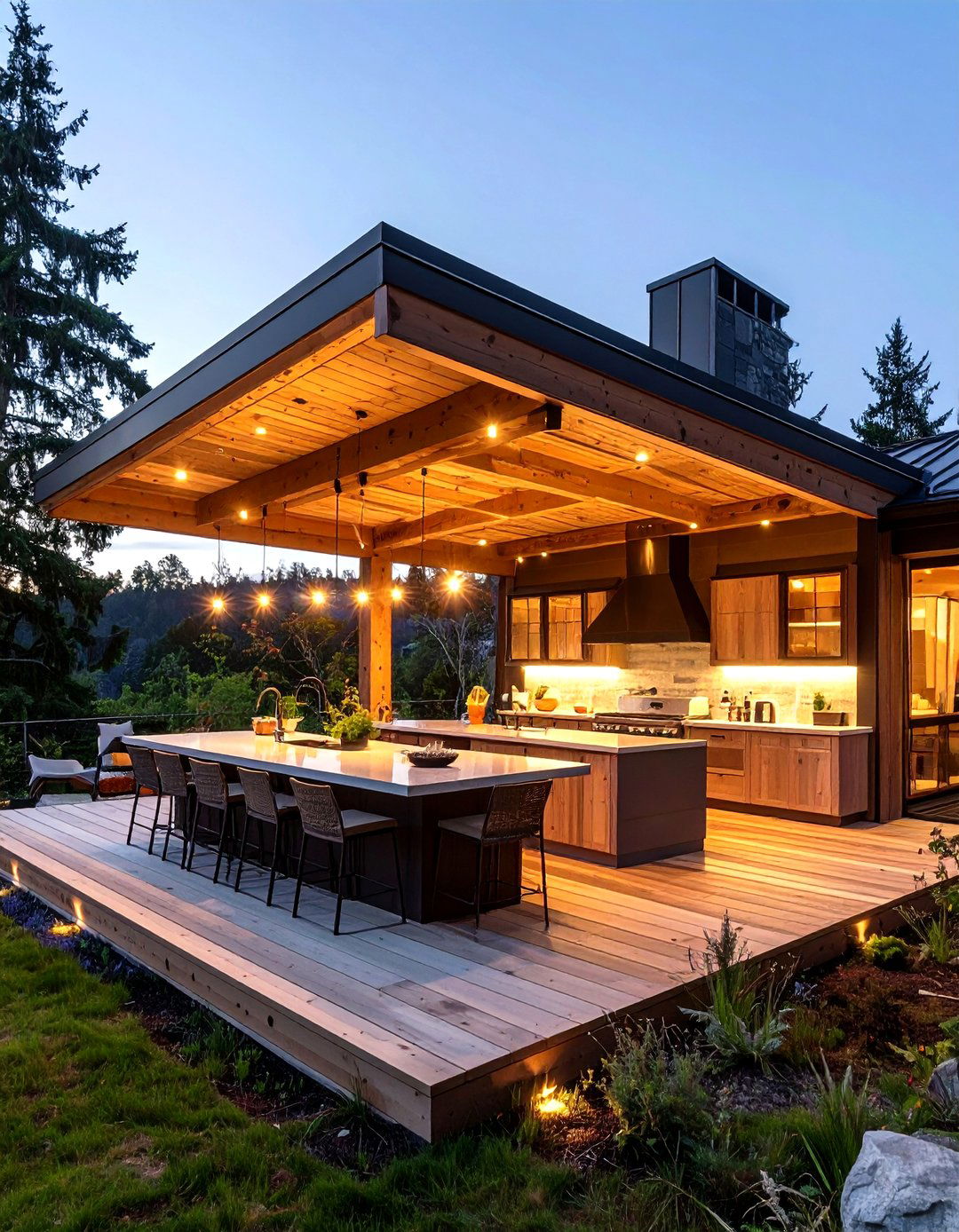
Glue-laminated cedar or spruce beams can span 15 feet or more, letting countertops jut under a hovering roof with no corner columns to dodge. This Old House’s cost guide notes that a cantilevered patio roof shields cooks from drizzle yet keeps sightlines open to the firepit or pool. Run concealed down-lighting inside the beam cavity for drama that seems to emanate from nowhere.
17. Arched Pergola Roof With Retractable Canvas Canopy
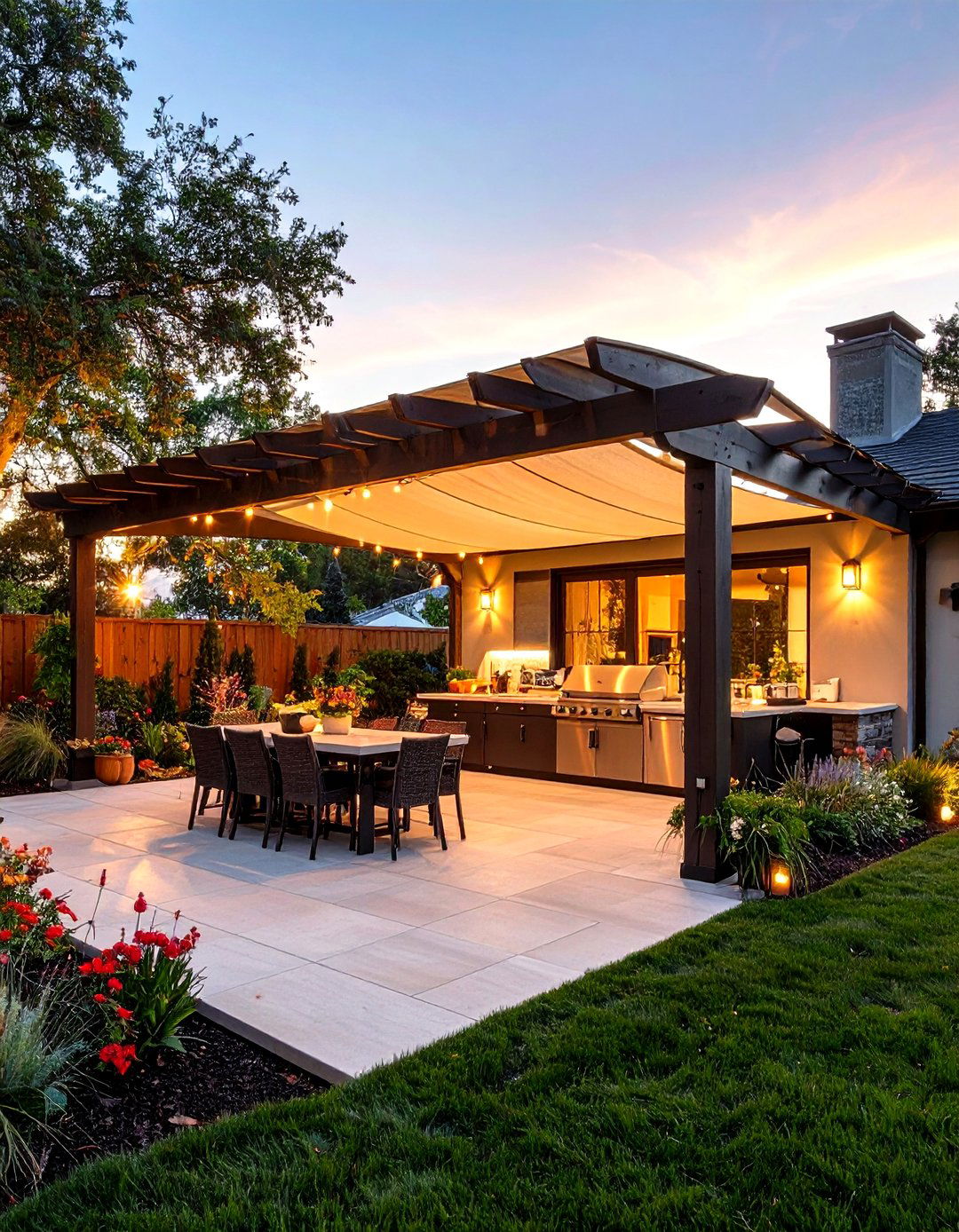
Combine the graceful curve of arched rafters with a manually sliding Sunbrella insert for all-season flexibility. Better Homes & Gardens shows how the billowing fabric diffuses high noon glare while closed, then folds neatly under the arch when you want sunshine. Waterproof acrylic weave means unexpected showers won’t soak seat cushions or the chef.
18. Tensioned Membrane Roof Echoes Modern Stadiums
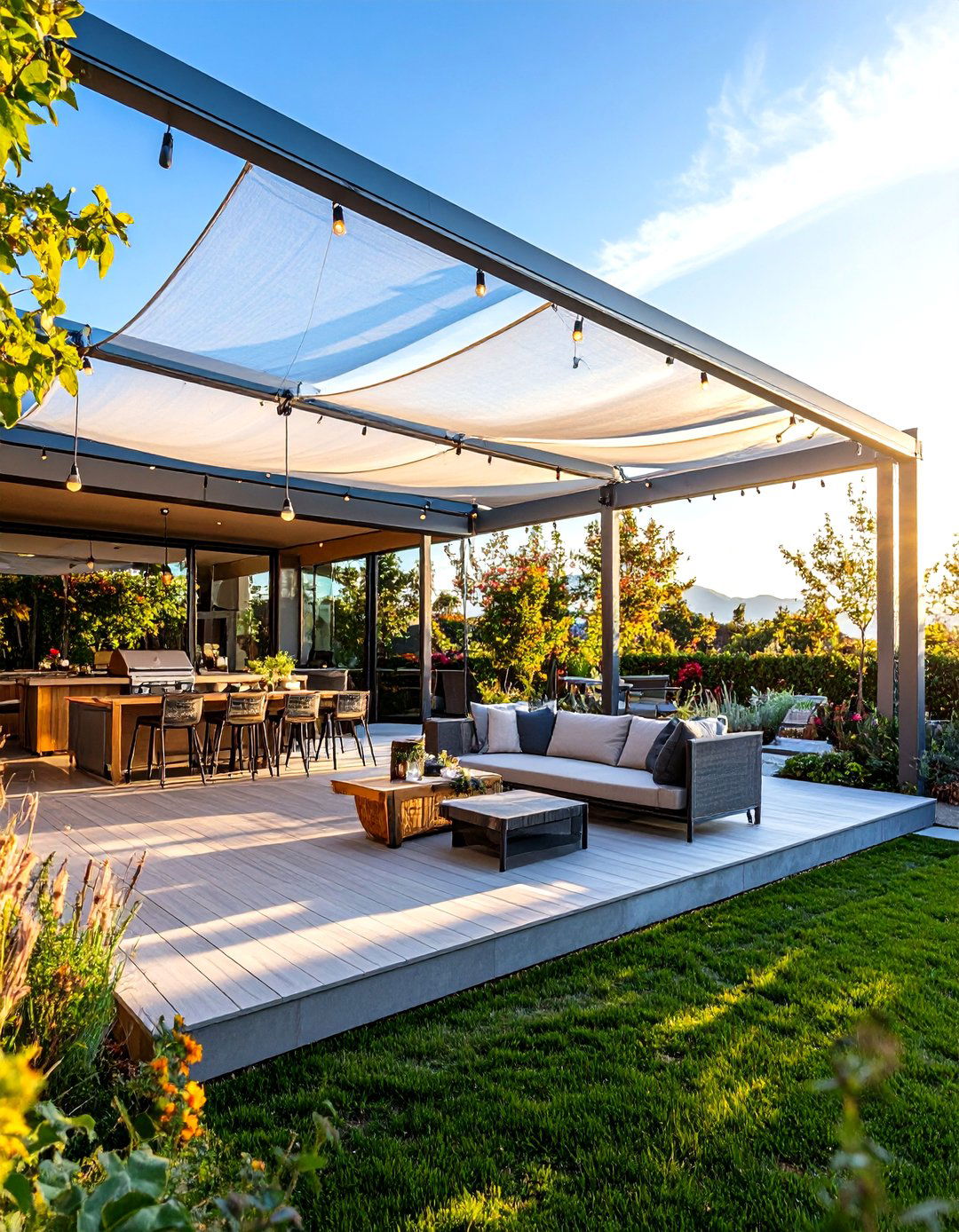
Architectural-grade PVC or PTFE membranes stretched over steel masts create a sail-like roof that feels right out of a contemporary arena. Suppliers report that these coatings self-clean in rain and transmit soft, diffused daylight, eliminating the cave effect common under solid roofs. Because fabric arrives pre-patterned, installers can finish most backyard sizes in a single day.
19. Paneled Glass Roof With Built-In UV Filter
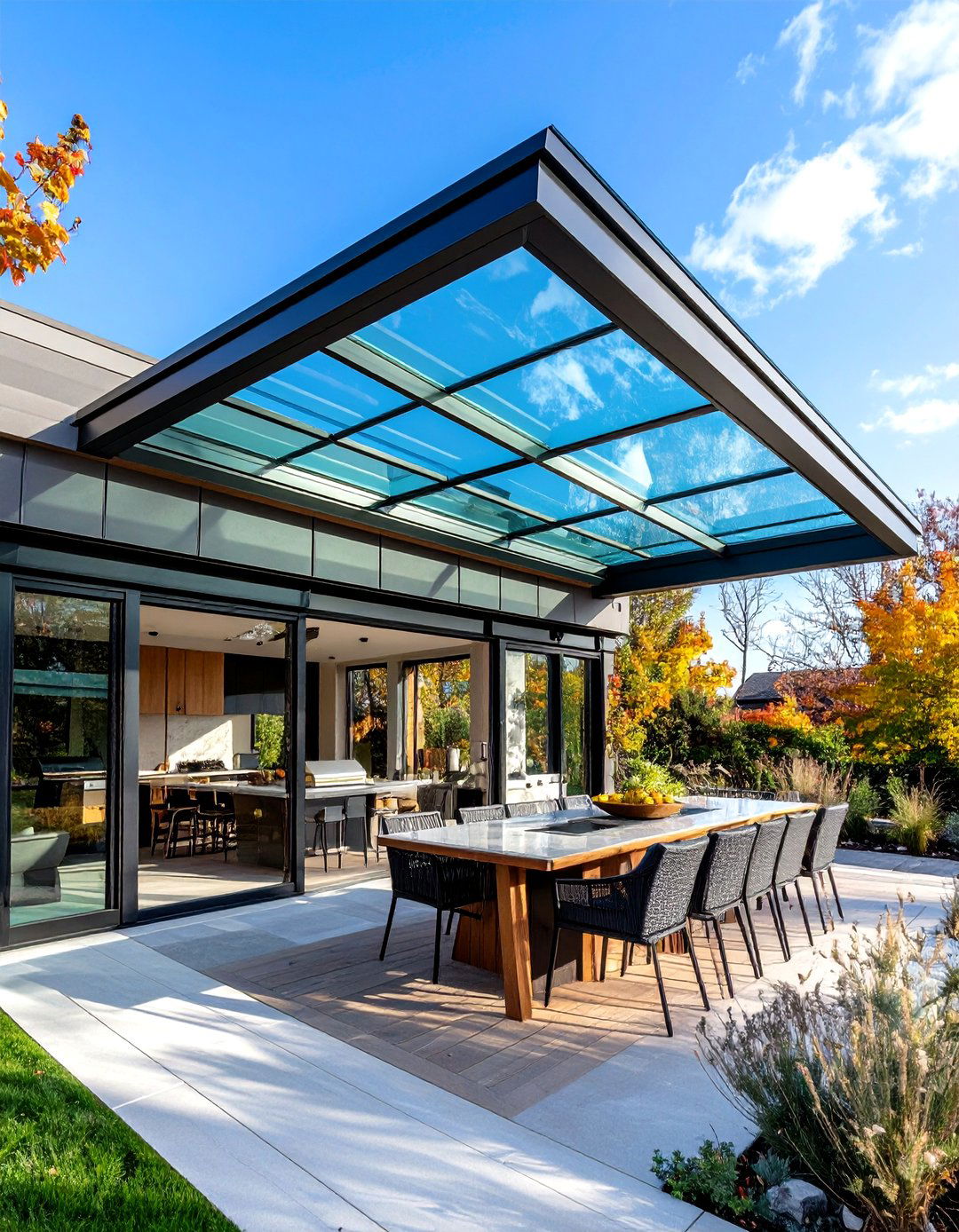
Laminated safety glass panels mounted on powder-coated joists bring indoor brightness outdoors while blocking damaging ultraviolet rays that age teak tables. Polyvinyl butyral interlayers filter sound too, so sizzling fajitas and dinner conversation remain audible during rainfall. Add top-hung awning windows along one edge to vent smoke without sacrificing the sleek greenhouse effect.
20. Convertible Umbrella Cluster Roof for Tight Budgets
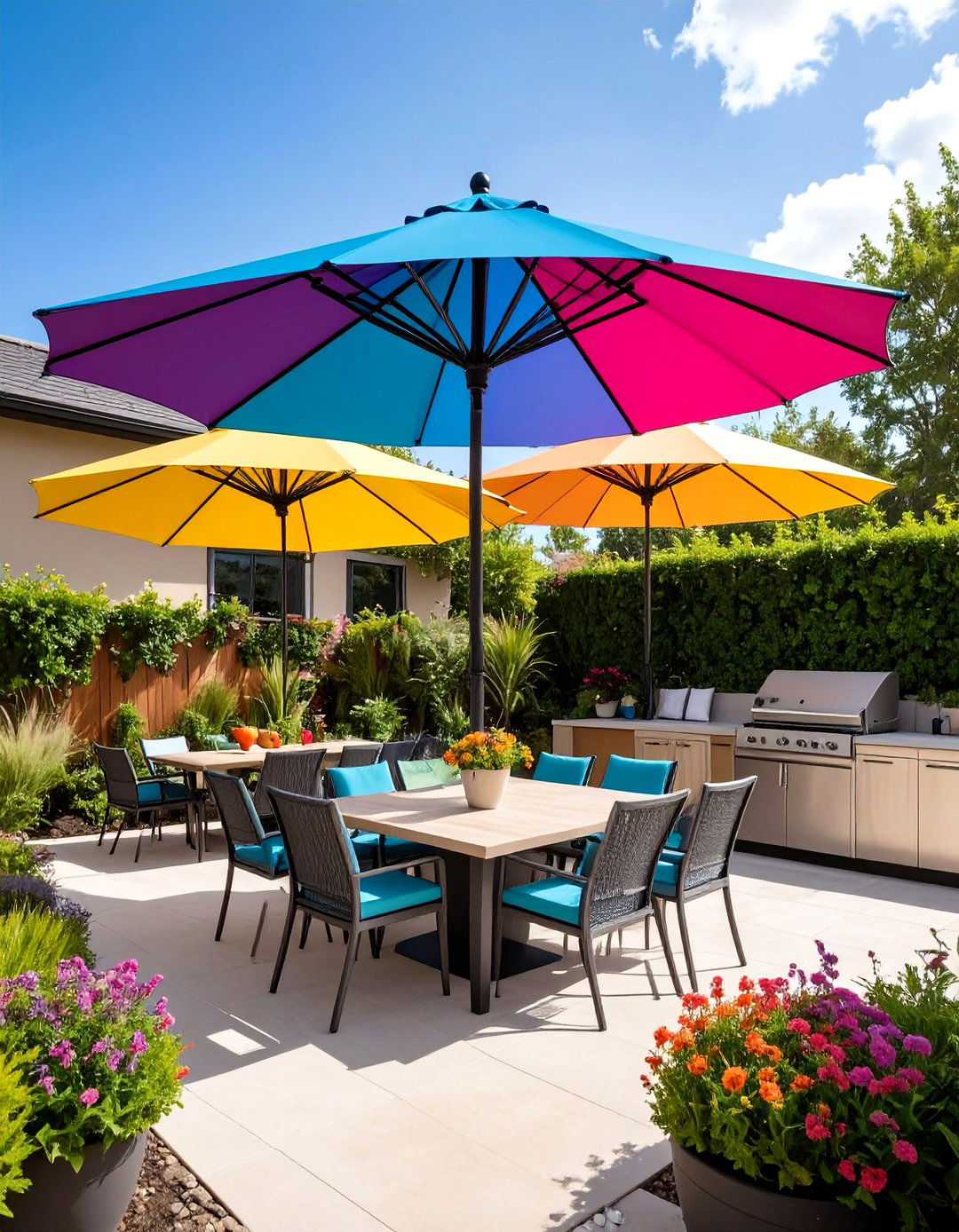
Three cantilever umbrellas arranged in a pinwheel instantly roof a starter kitchen and pivot independently with the sun. Real Simple lists umbrellas as the most flexible, cost-effective shade because they close in storms and relocate if you move grills around. Look for Sunbrella fabric and weighted granite bases to survive windy afternoons.
21. Bamboo-Lathe Roof Exudes Eco-Chic Warmth
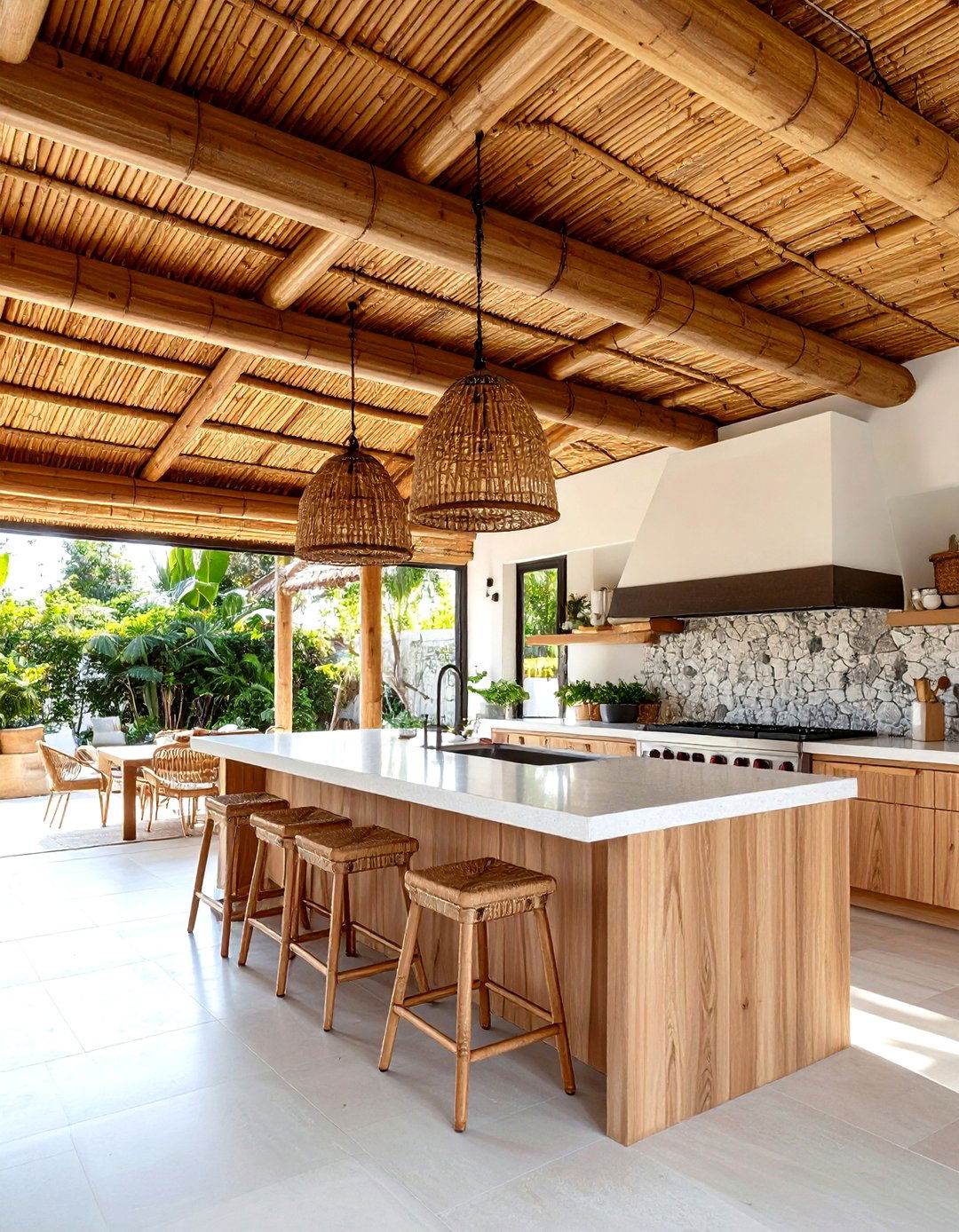
Interlacing thin bamboo poles over a simple pine frame yields a dappled shade pattern reminiscent of tropical cafés. Designers on Houzz praise bamboo for being renewable, fast-growing, and naturally water-resistant when sealed with tung oil. Combine with lava-stone counters and rattan stools for cohesive, low-carbon flair.
22. Trellis Roof With String-Light Lattice Sparks Evening Magic
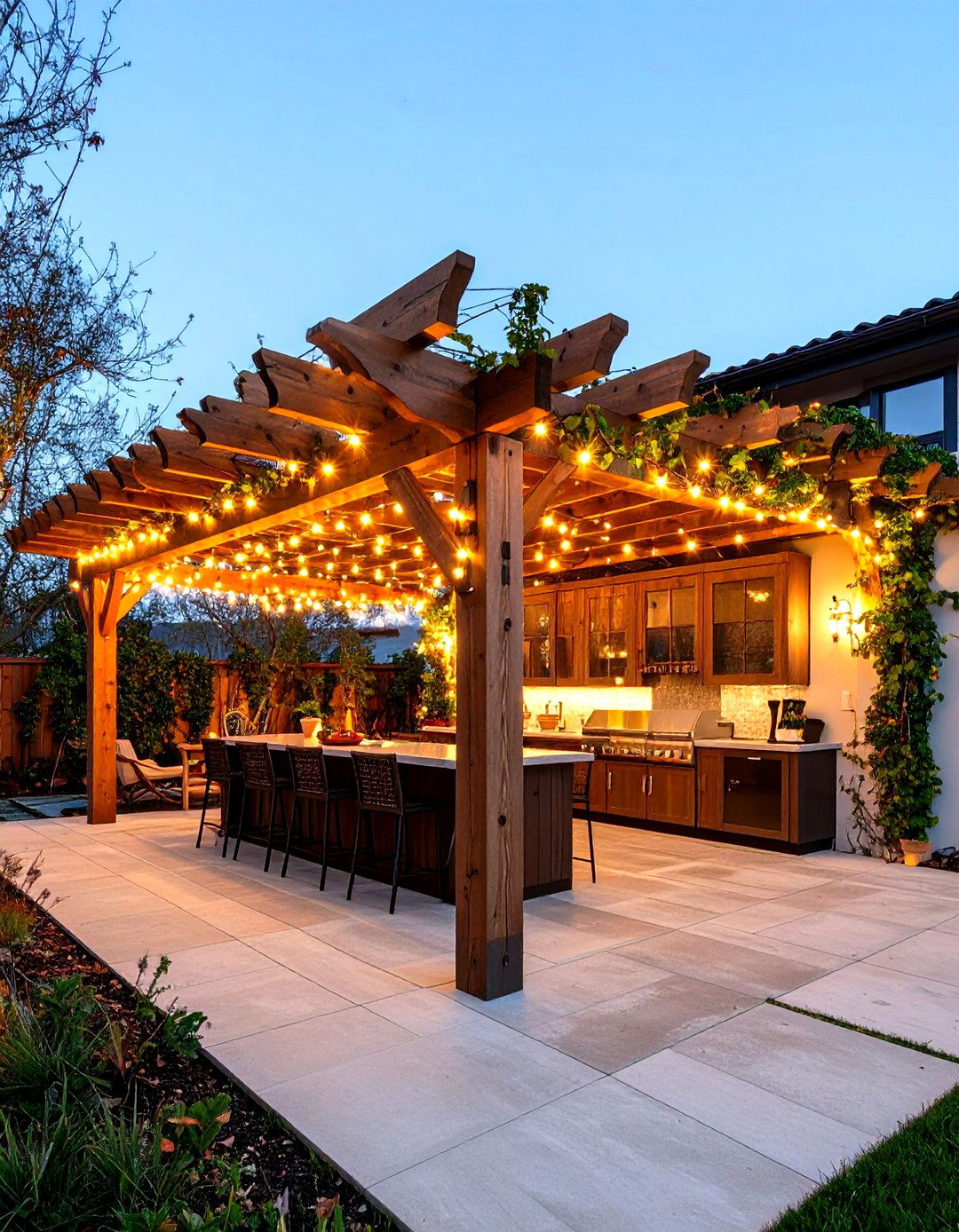
A double-layer wooden trellis roof not only shades prep stations but also hides the wiring for hundreds of warm-white LEDs. The Spruce’s lighting guide recommends pairing classic Edison bulbs with vine-wrapped beams for café ambience that costs pennies per hour to run. Install dimmers to shift from meal prep brightness to cocktail-hour glow.
23. Steel Pergola Roof and Laser-Cut Privacy Screens
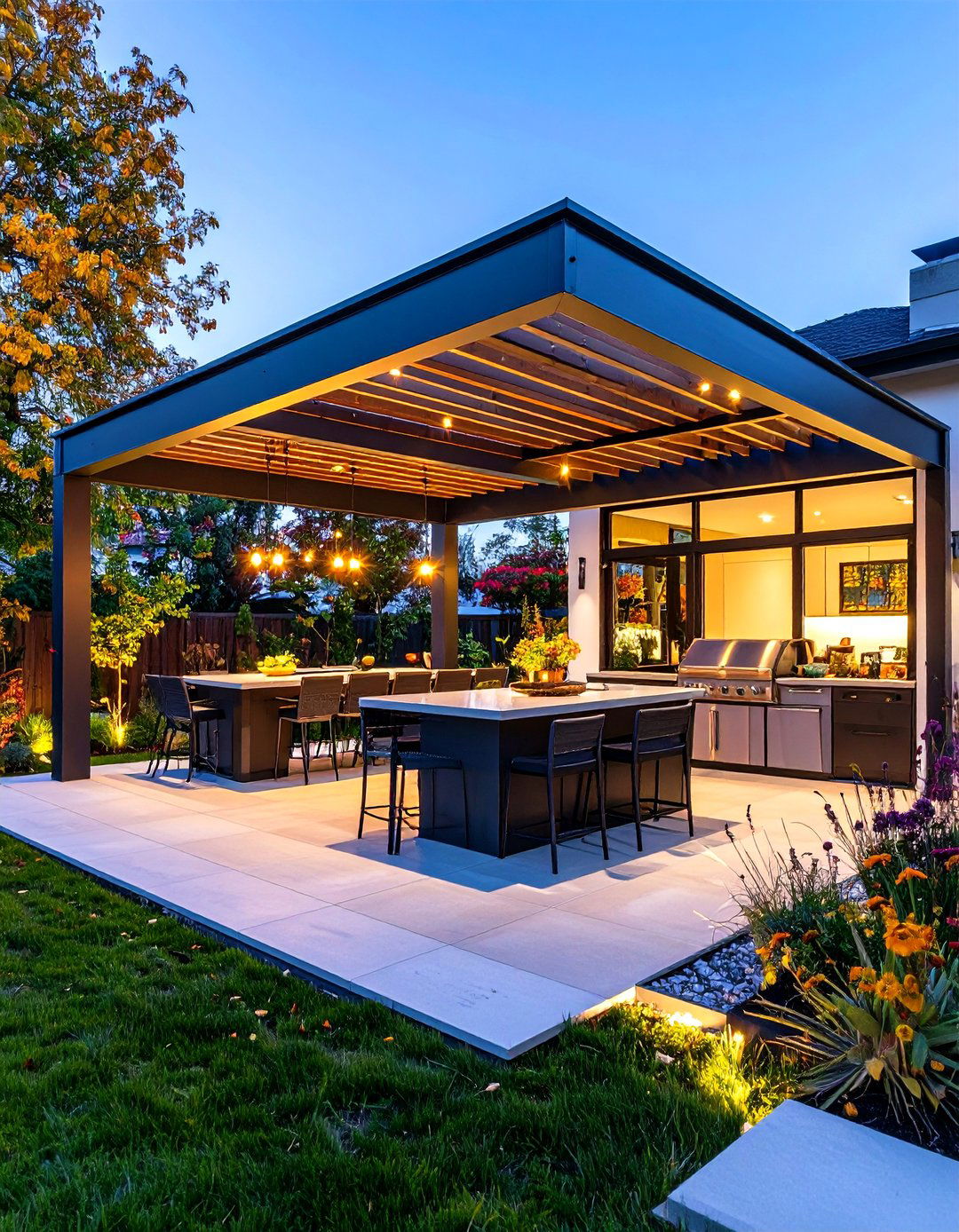
Powder-coated steel beams shrug off coastal humidity and accept bolt-on Corten or aluminum privacy panels that block cross-winds. Equinox and StruXure dealers note that structural steel allows slimmer profiles than wood, maximizing overhead clearance for tall smokers or pizza-oven chimneys. Match the screens’ pattern to deck railings for cohesive, modern lines.
24. Mixed-Material Roof Marries Wood Warmth and Industrial Cool
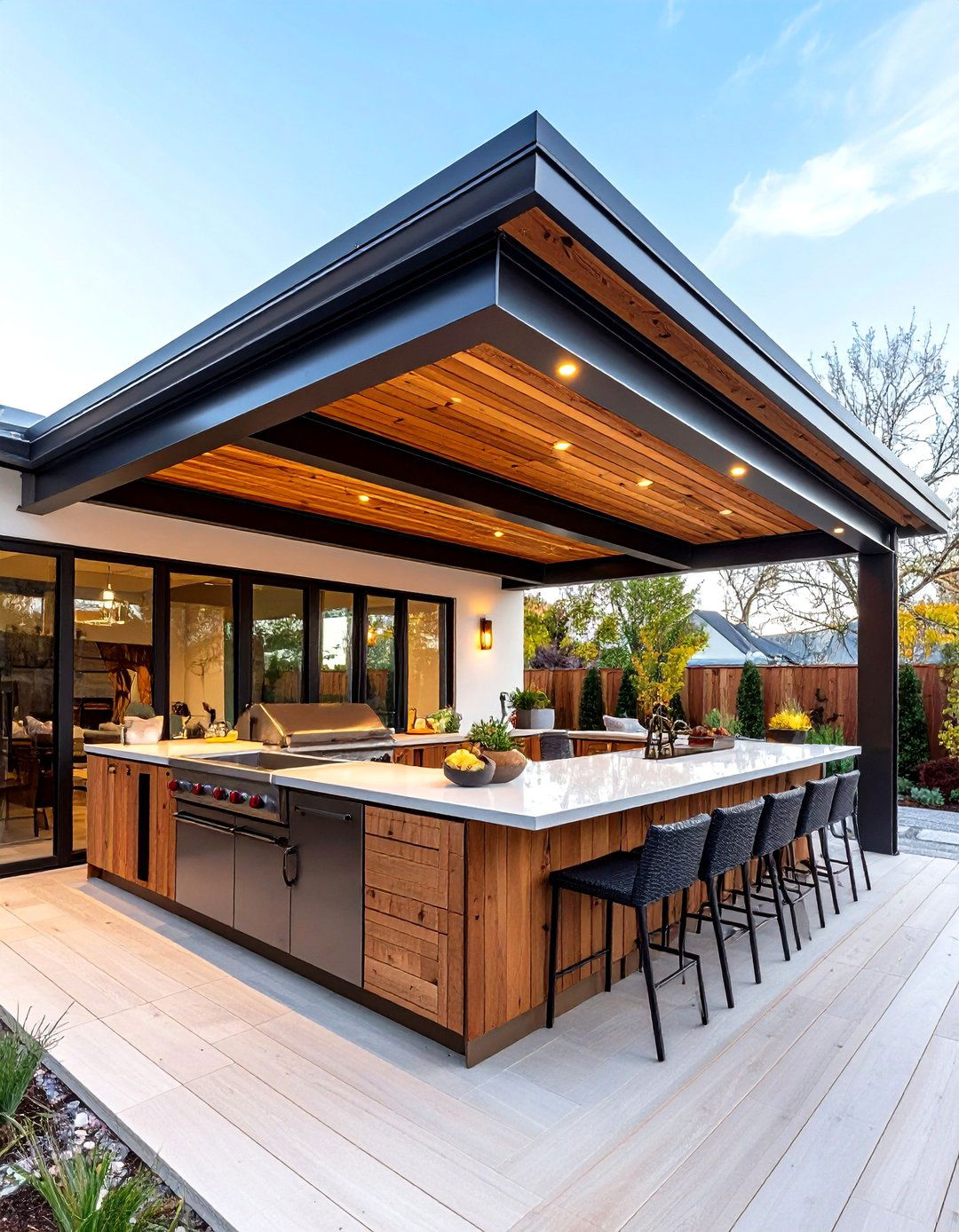
Can’t decide between cedar charm and steel durability? Combine parallel steel I-beams with inset cedar slats. The Spruce calls mixed roofing a growing trend for homeowners seeking contrast without clashing. Metal edges handle load and integrate gutters, while the timber core softens acoustics and accepts down-lights. A simple annual oil keeps boards richly toned.
25. Fold-Down Wall-Mount Roof for Compact Patios
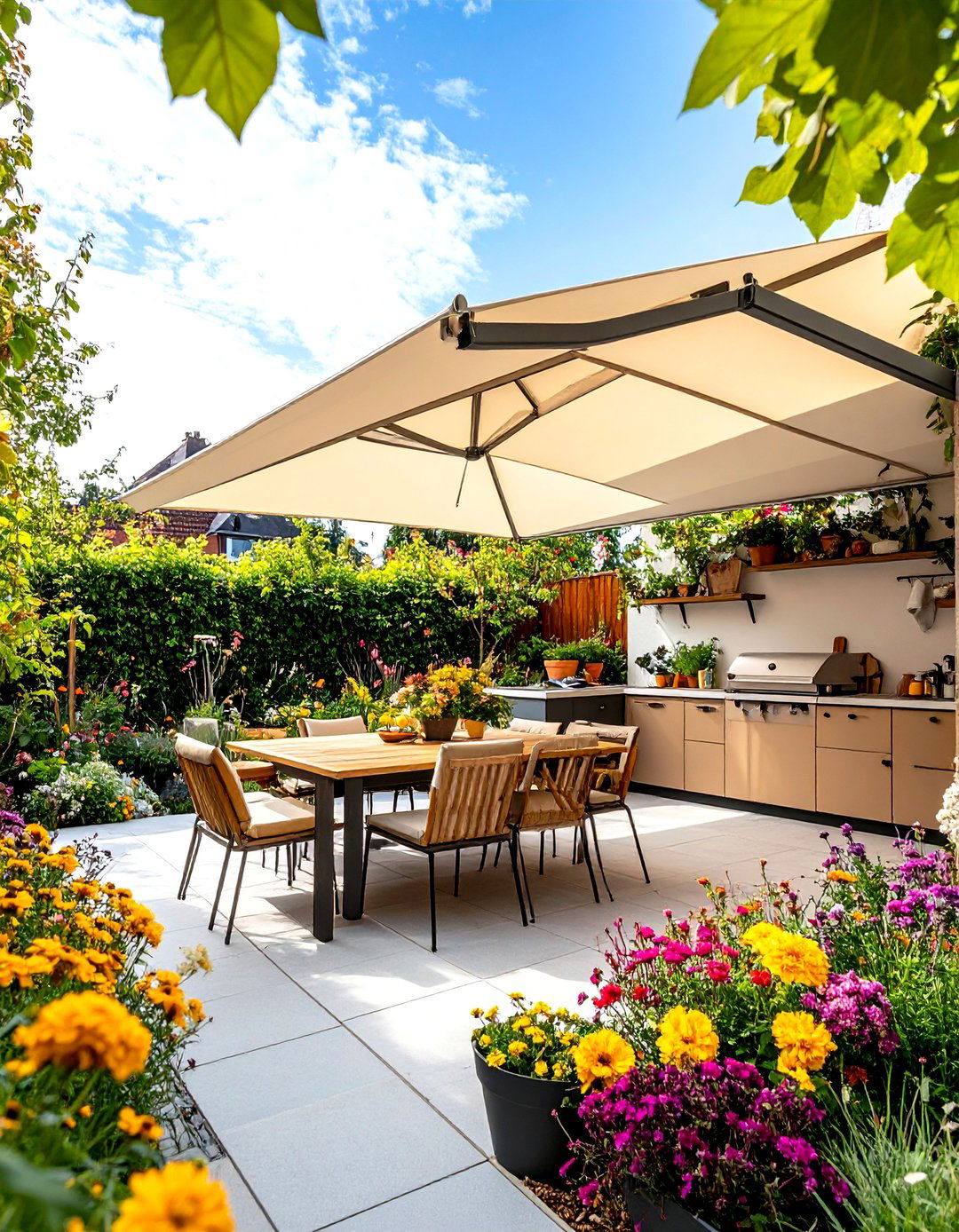
Urban courtyards might lack room for posts; instead, mount a hinged aluminum roof panel to the house that folds out like a giant awning. Suns Lifestyle showcases models with adjustable arms that lock at multiple angles, channeling rain away or lying flat against the façade when not in use. It’s an ingenious way to protect a narrow galley-style kitchen without crowding the walkway.
Conclusion:
Choosing the right outdoor kitchen roof is a balancing act between style, climate, budget, and the way you cook outside. From tech-savvy louvered systems and energy-producing solar canopies to simple shade sails and fold-down awnings, every option above delivers purposeful shelter while setting a distinct mood. Match materials to your home, plan drainage and lighting early, and you’ll gain a dependable, inviting extension of your indoor kitchen that serves burgers, brisket, or brunch in comfort for years to come.


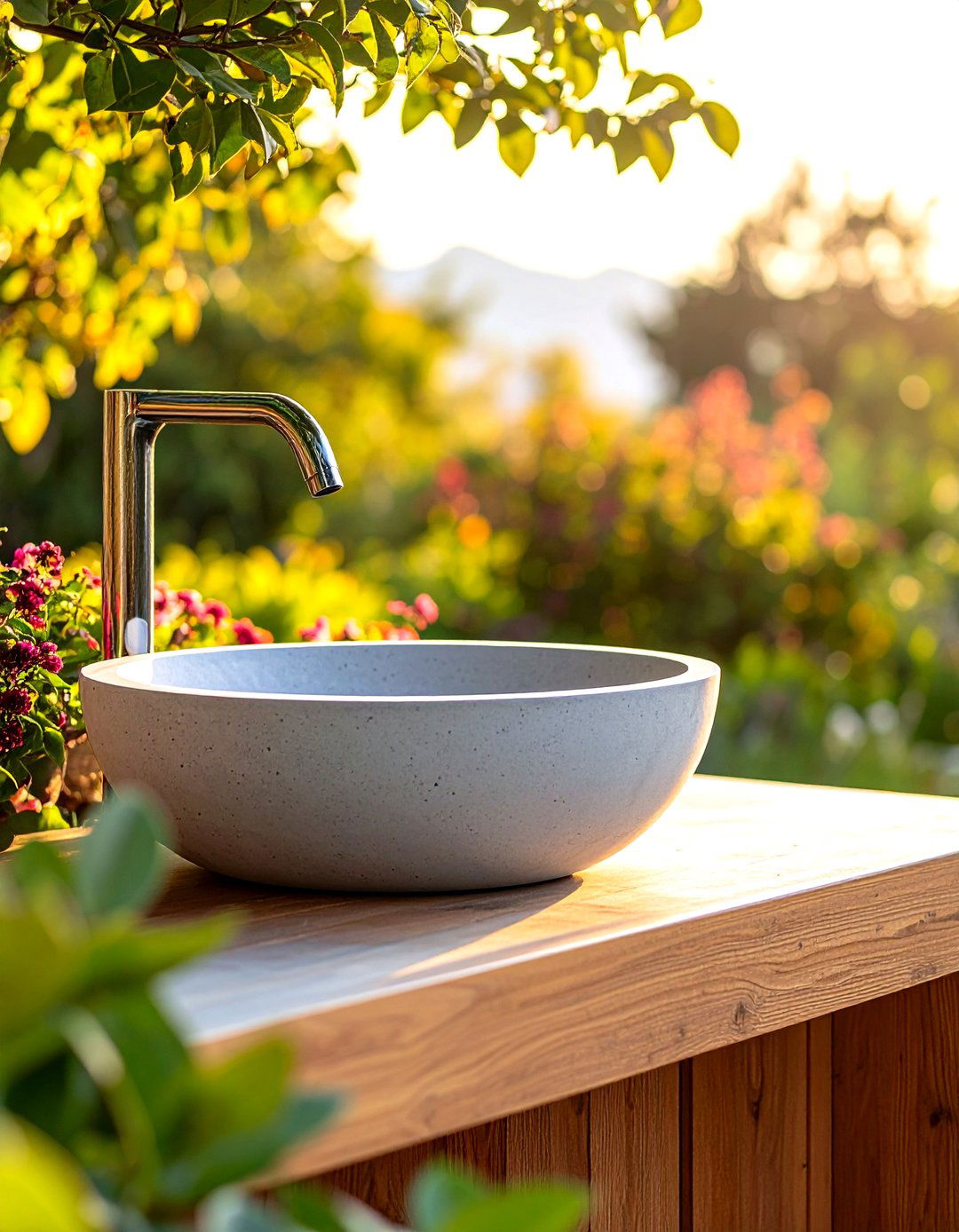
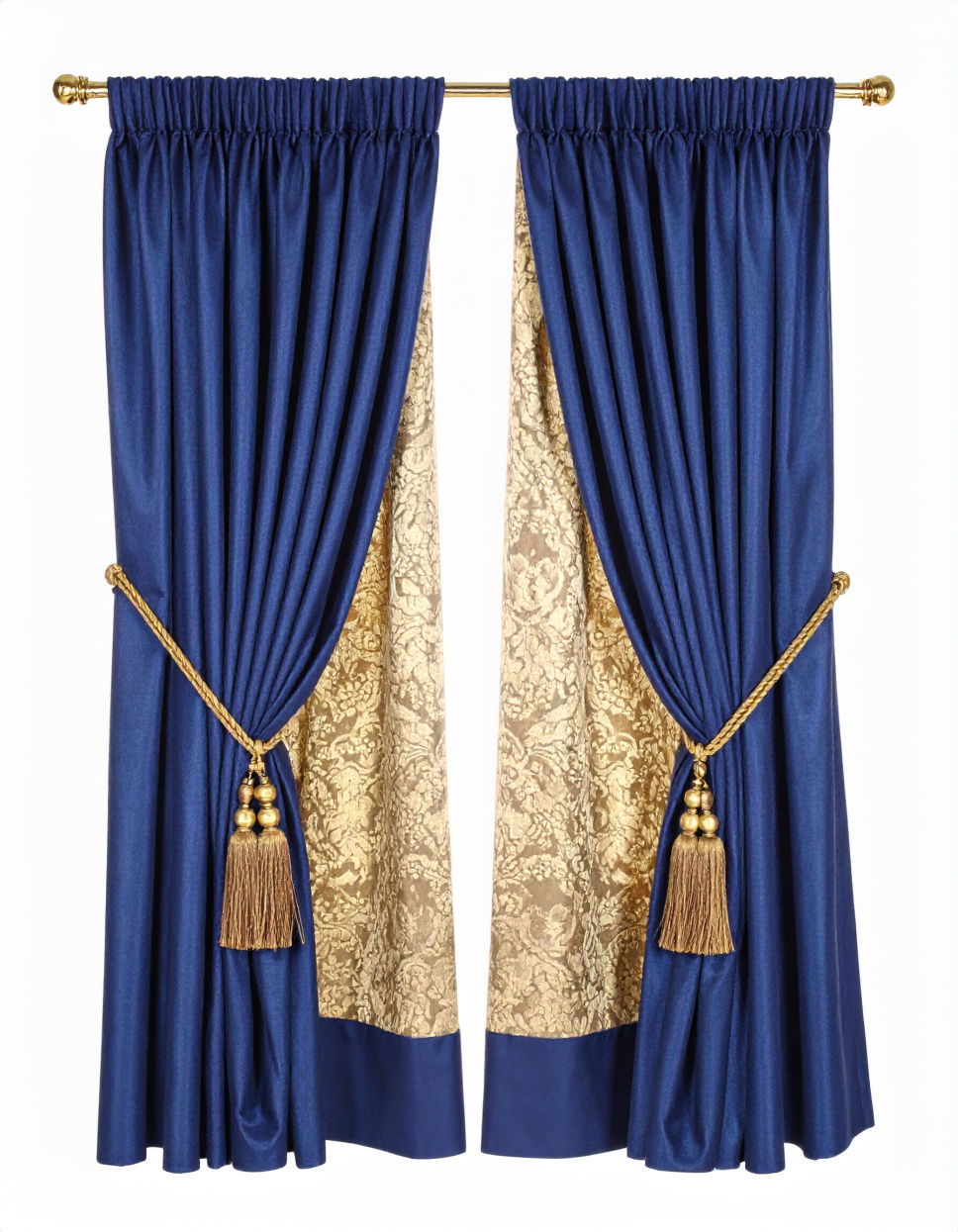

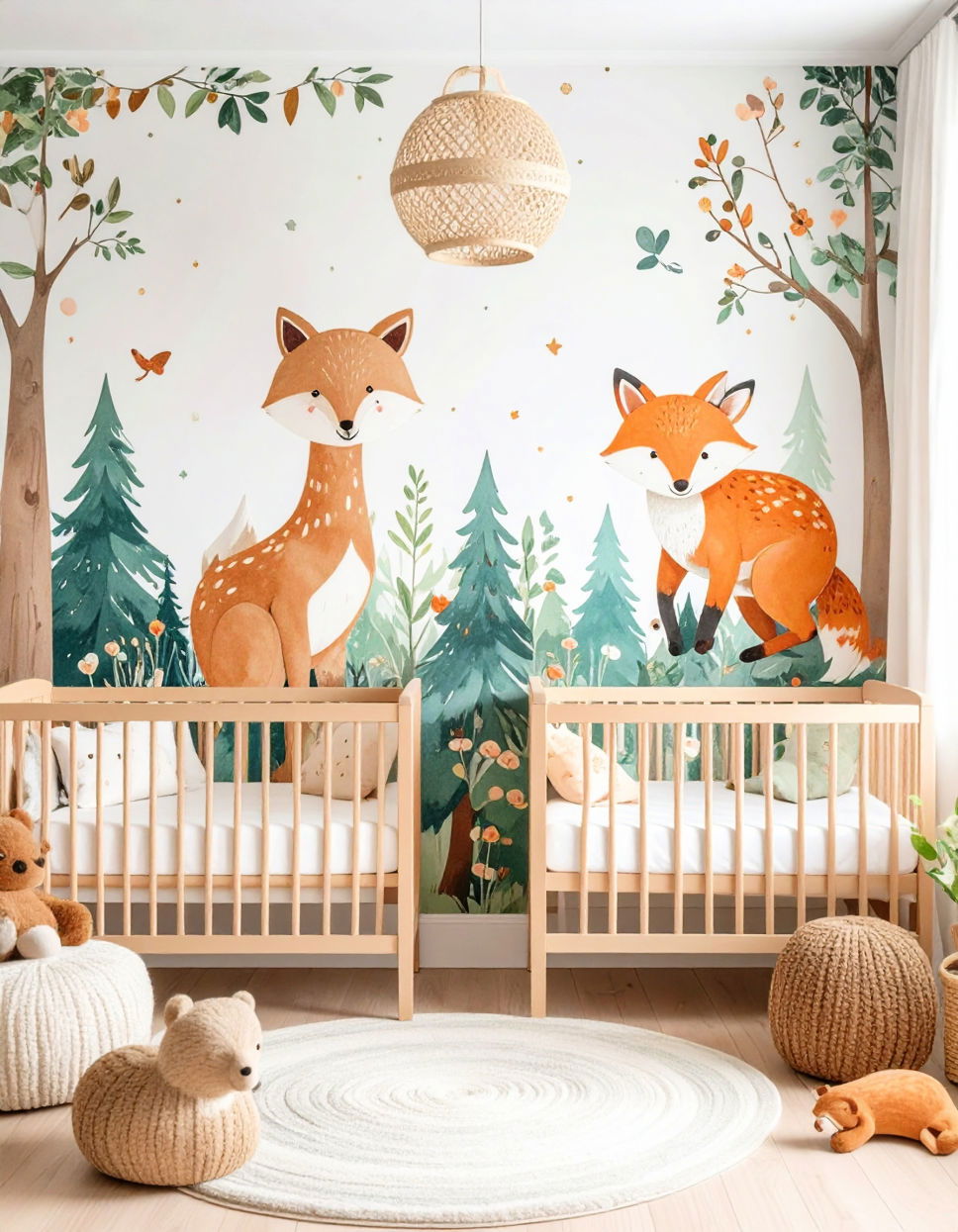
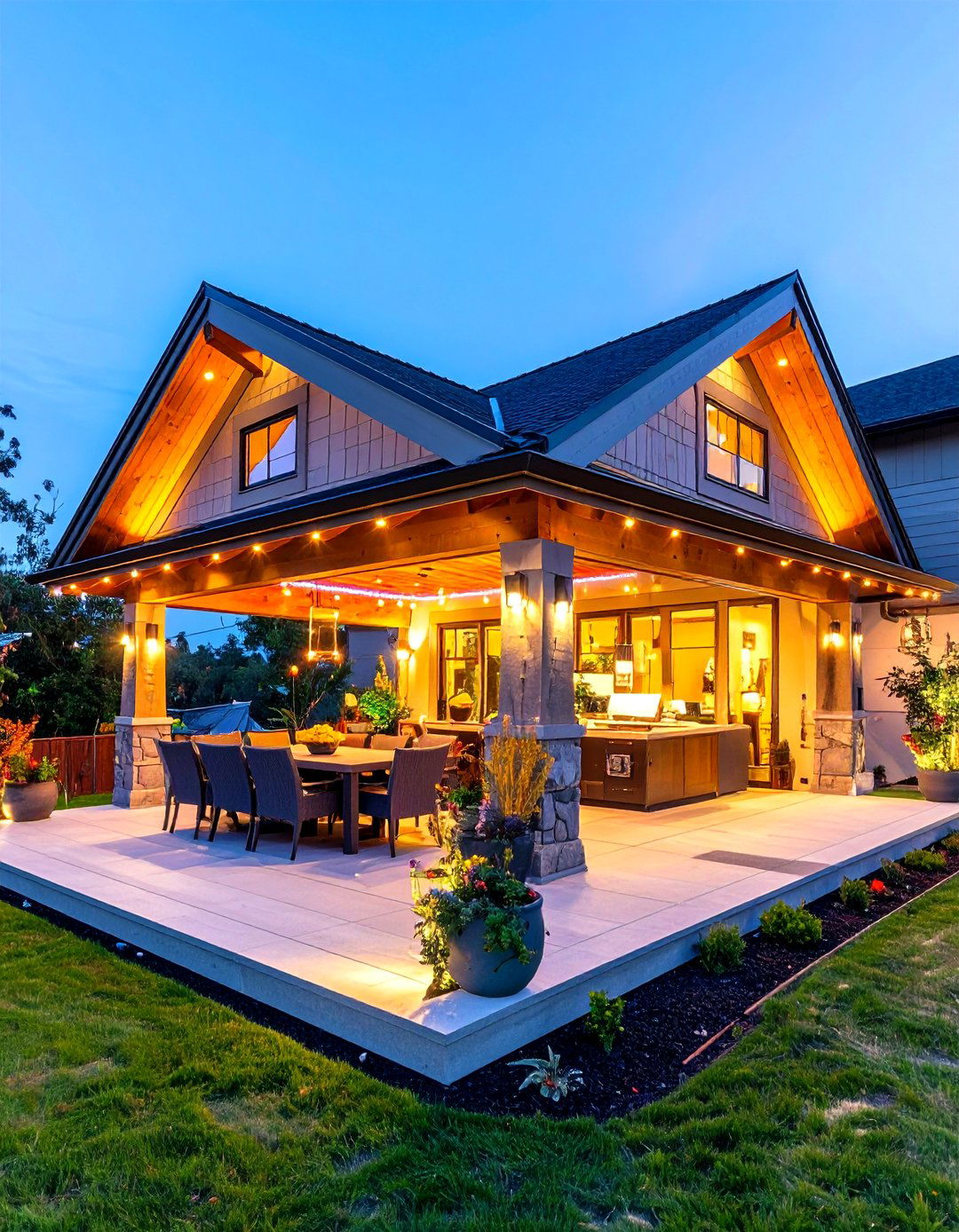
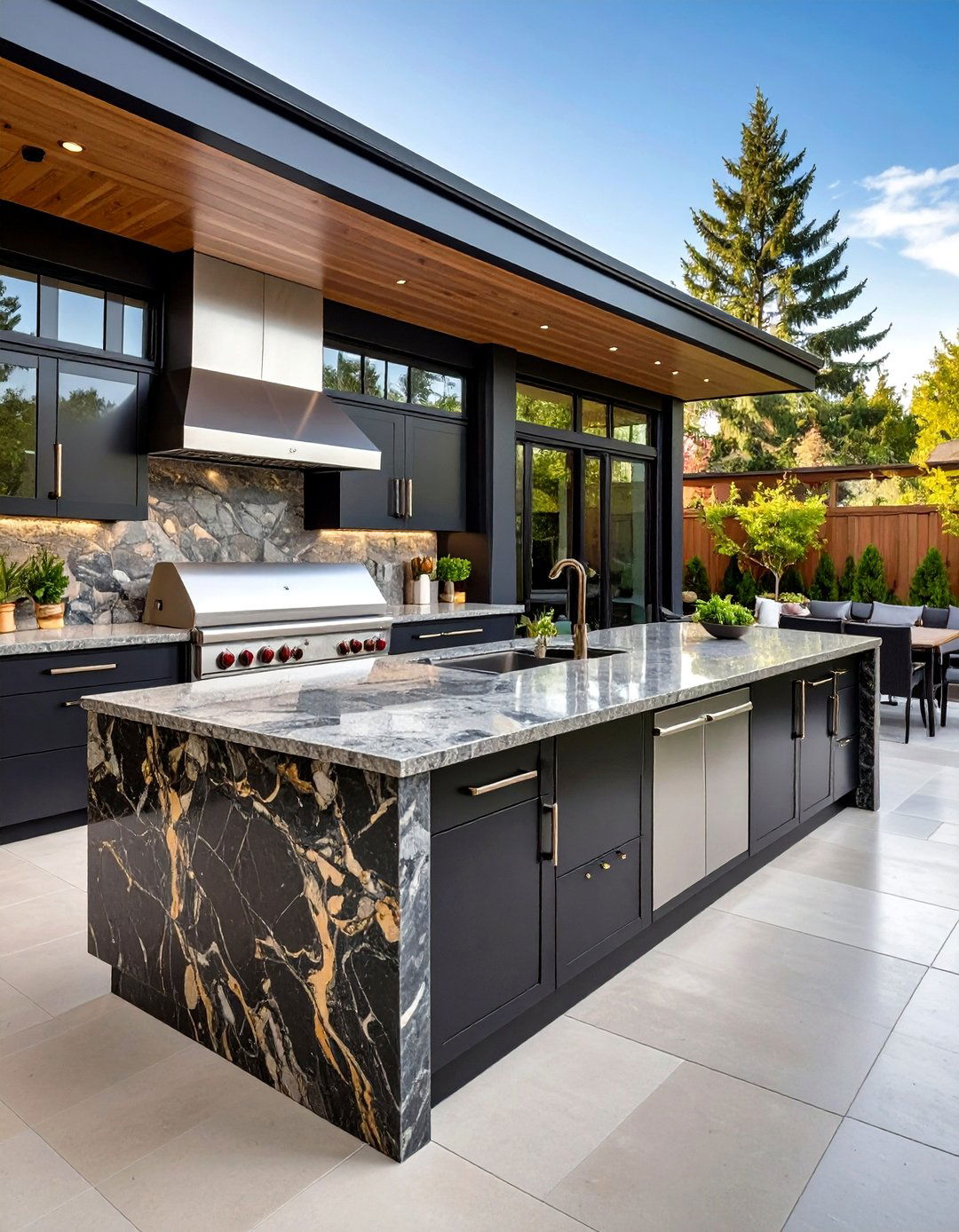
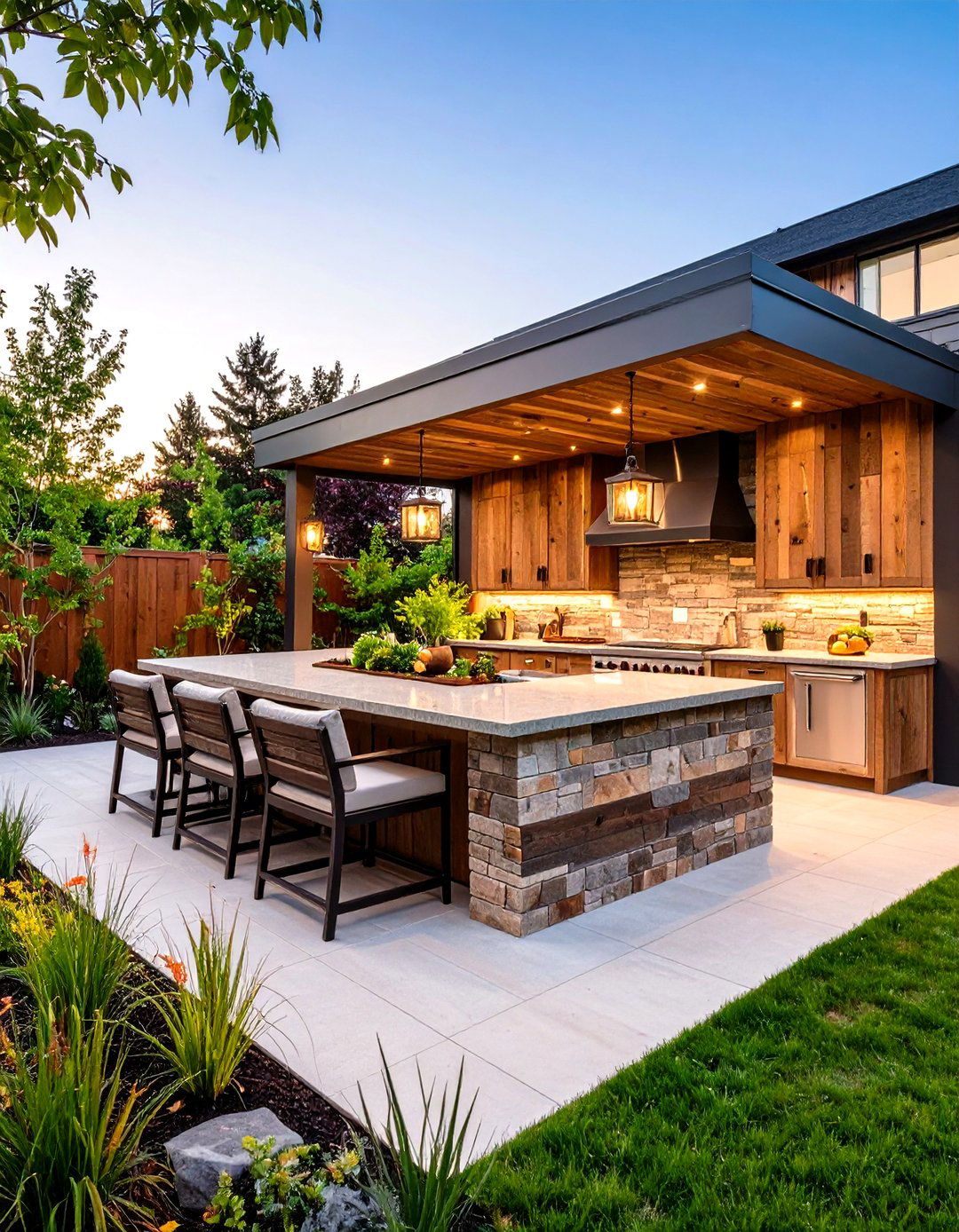
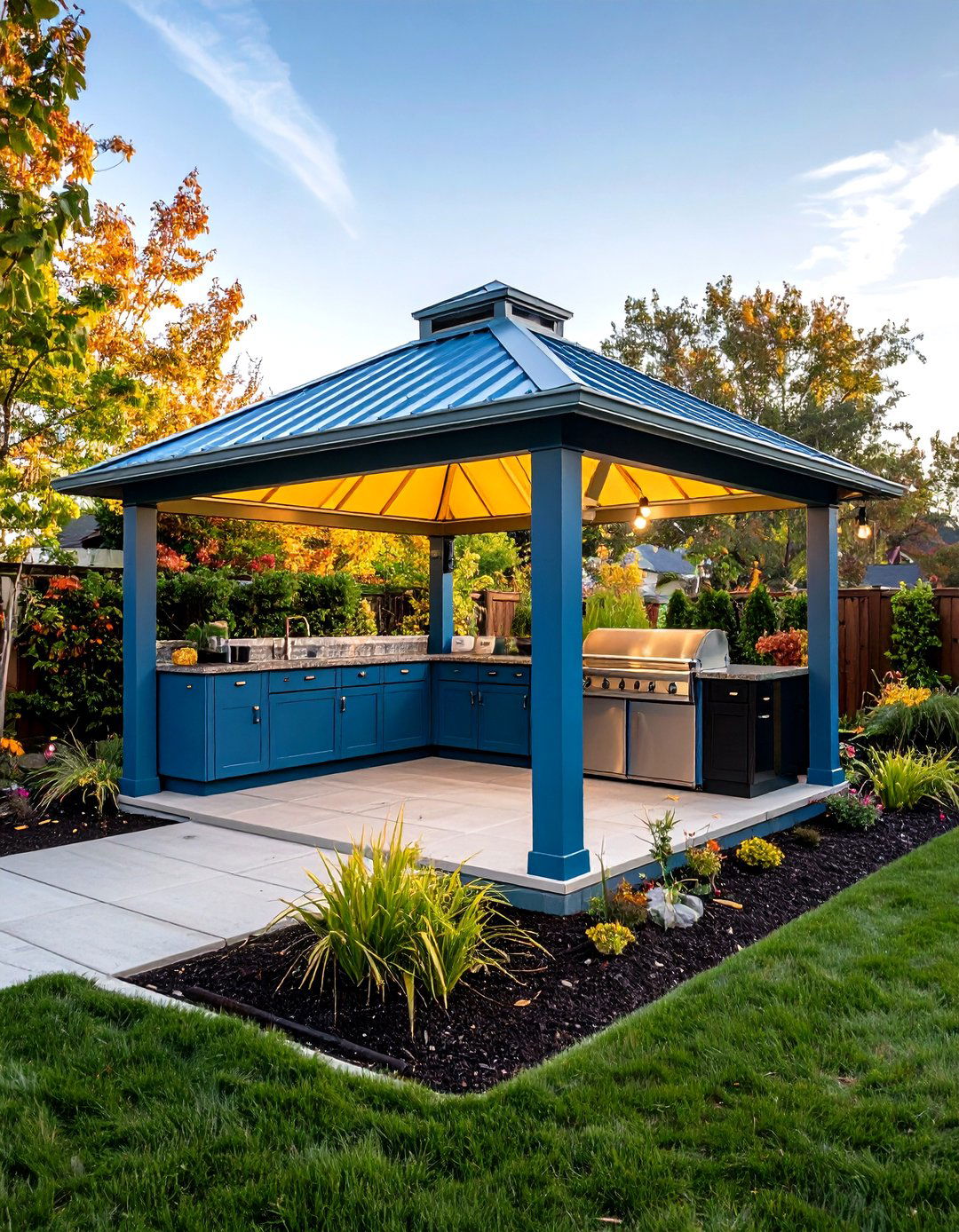
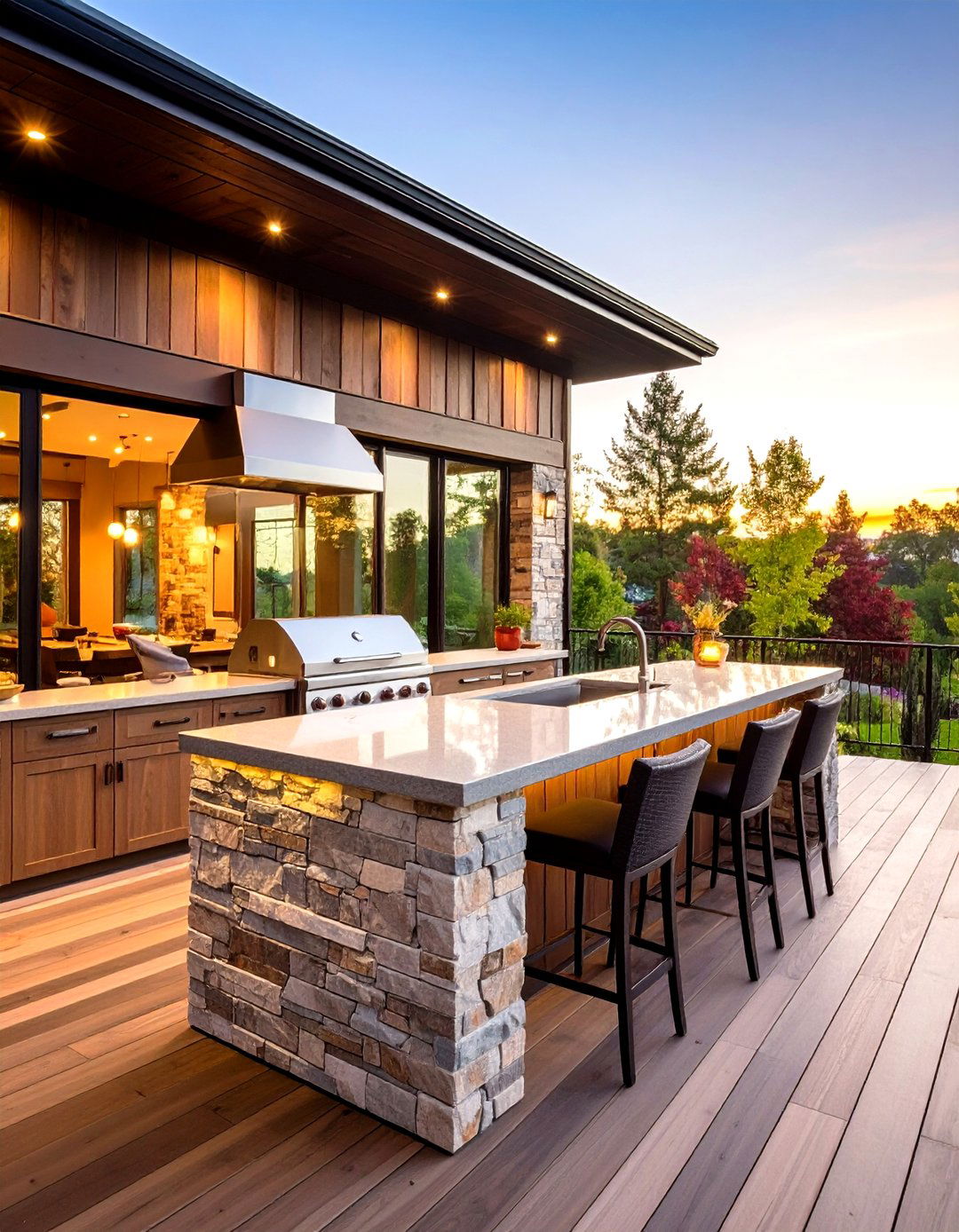
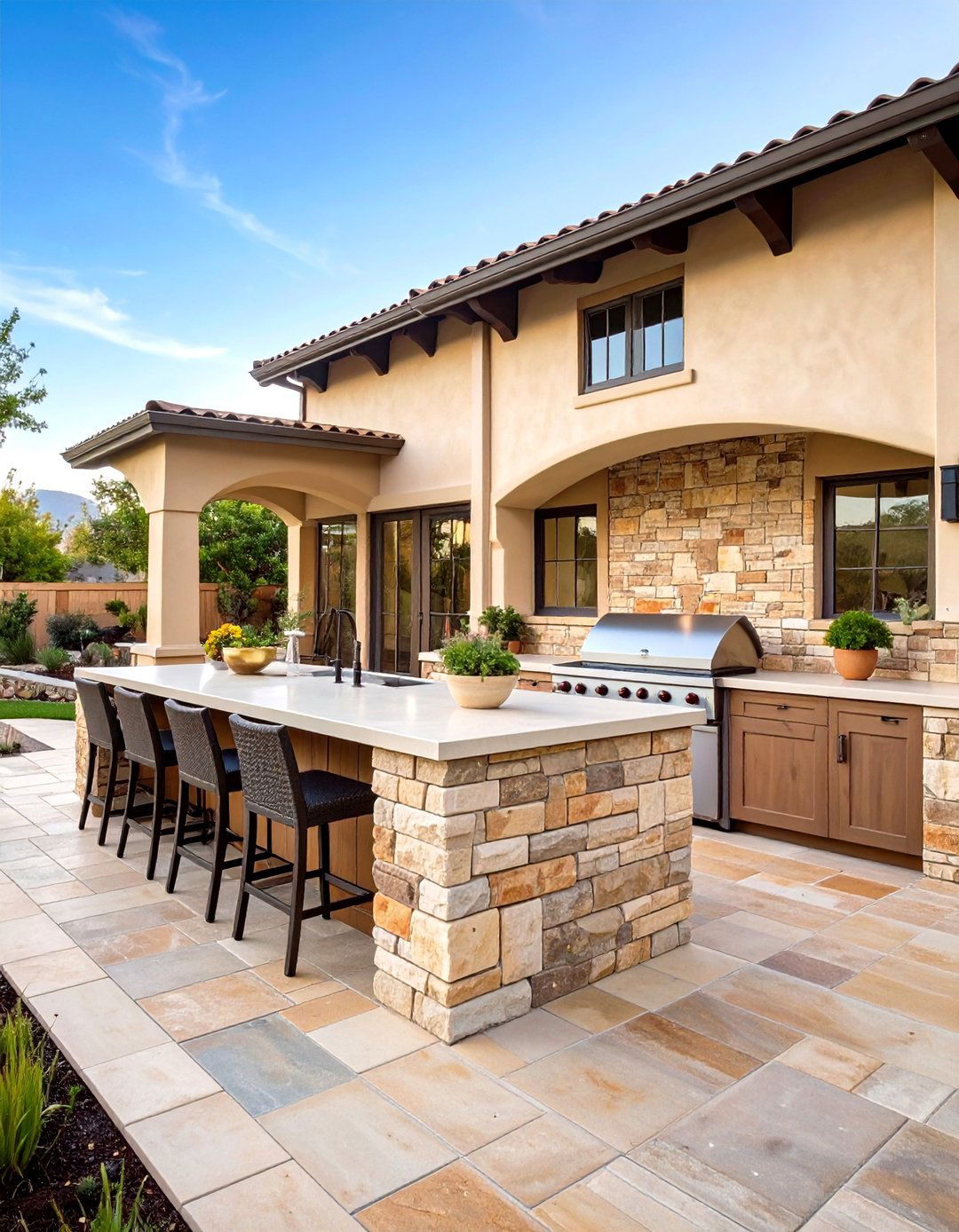
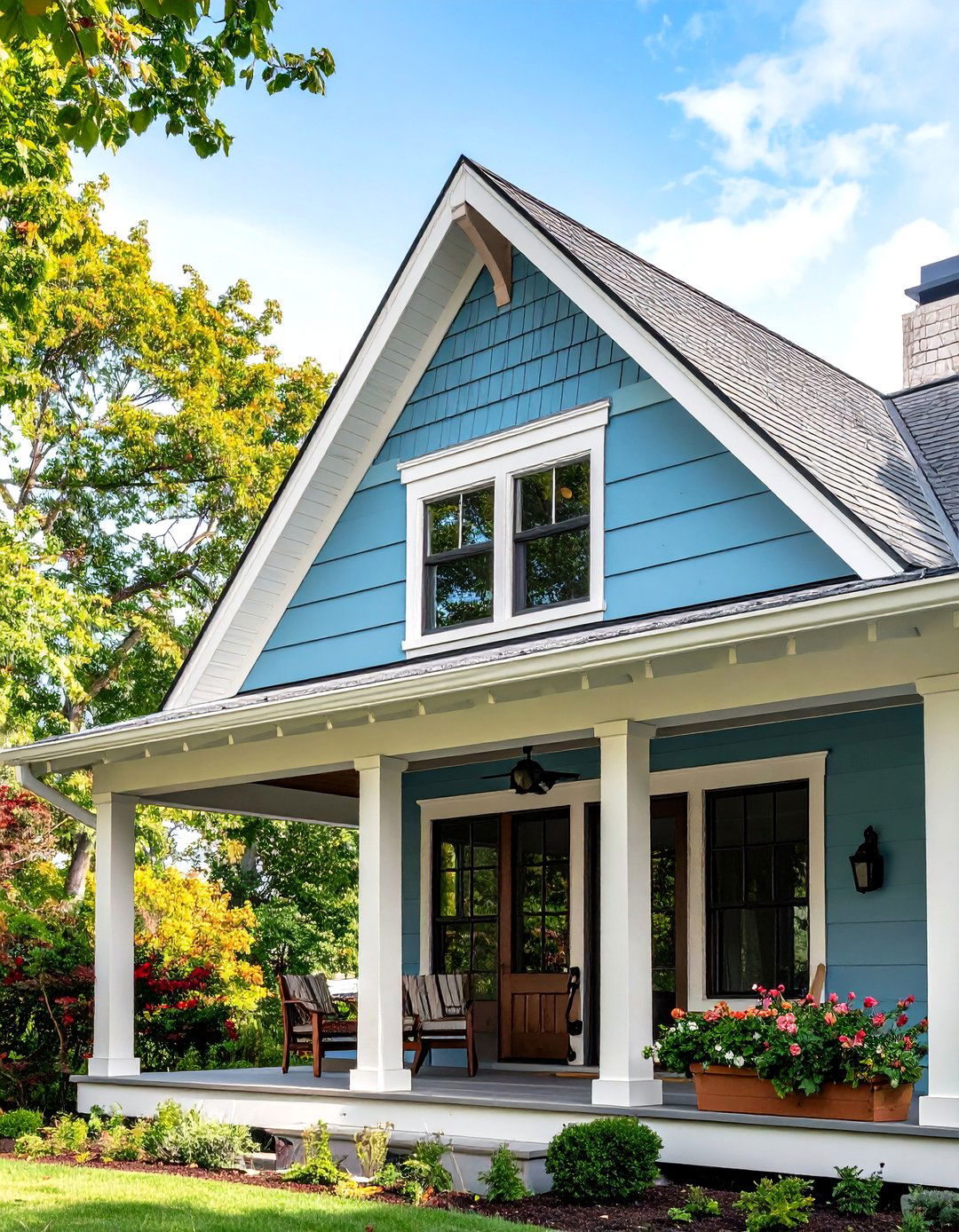
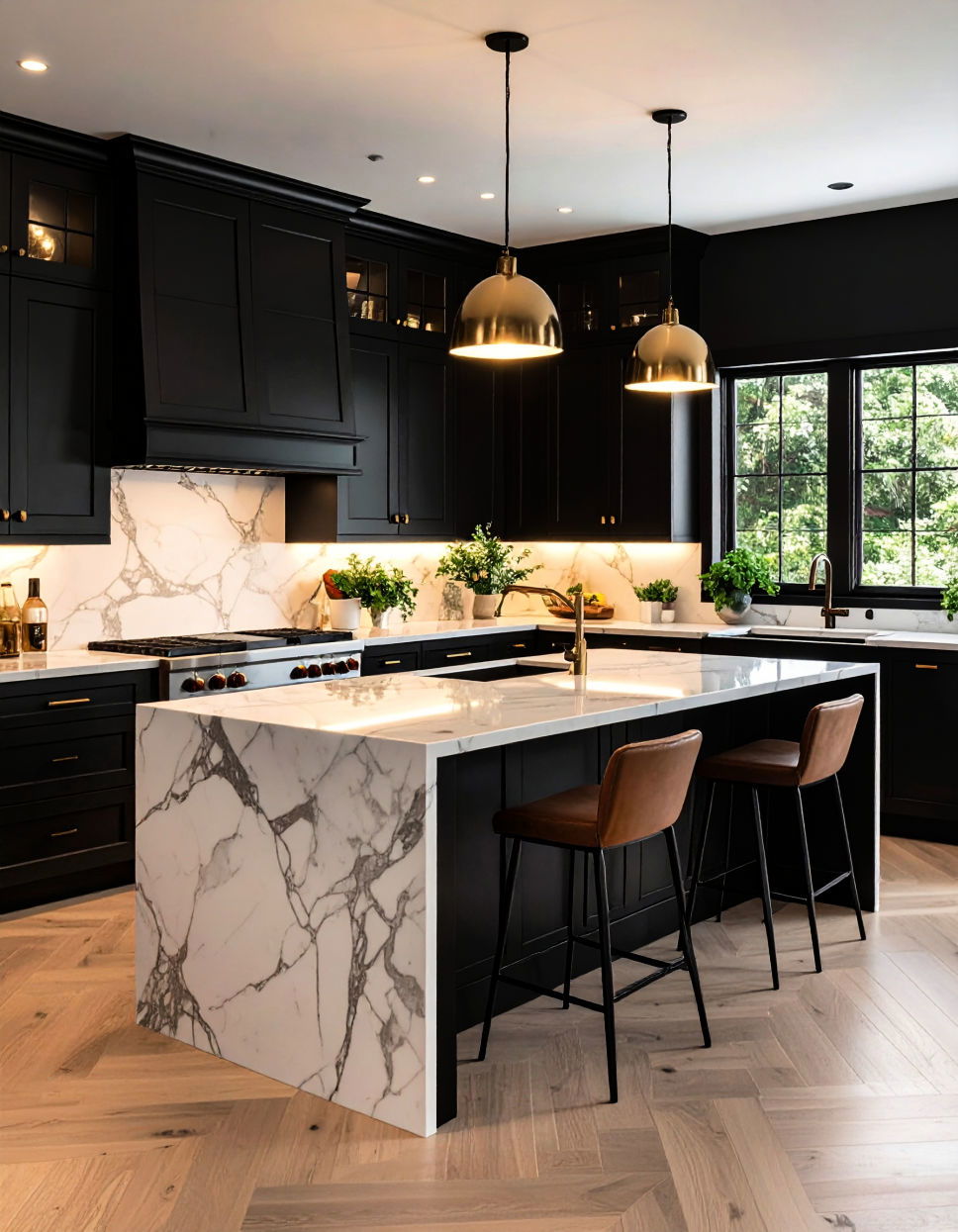
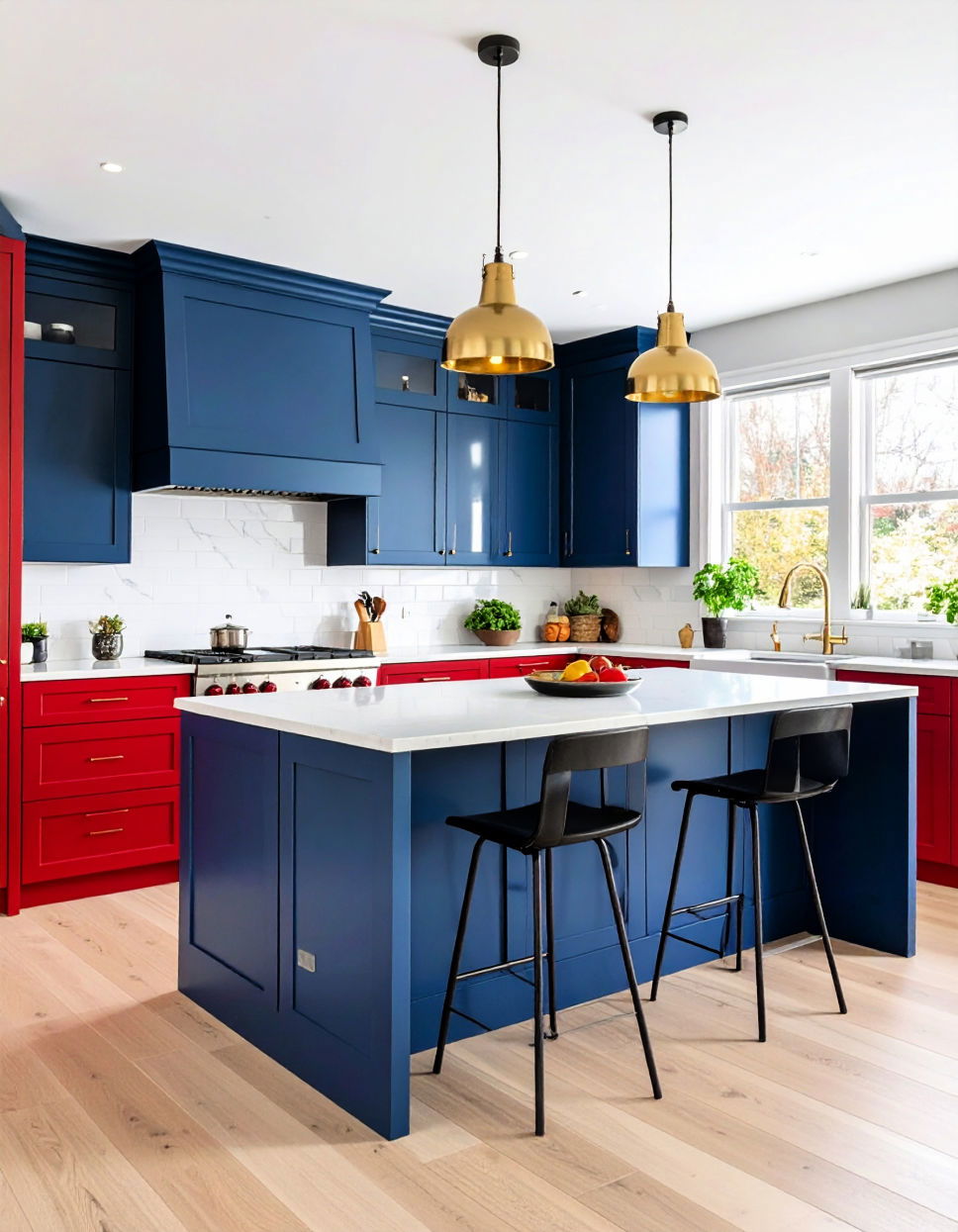
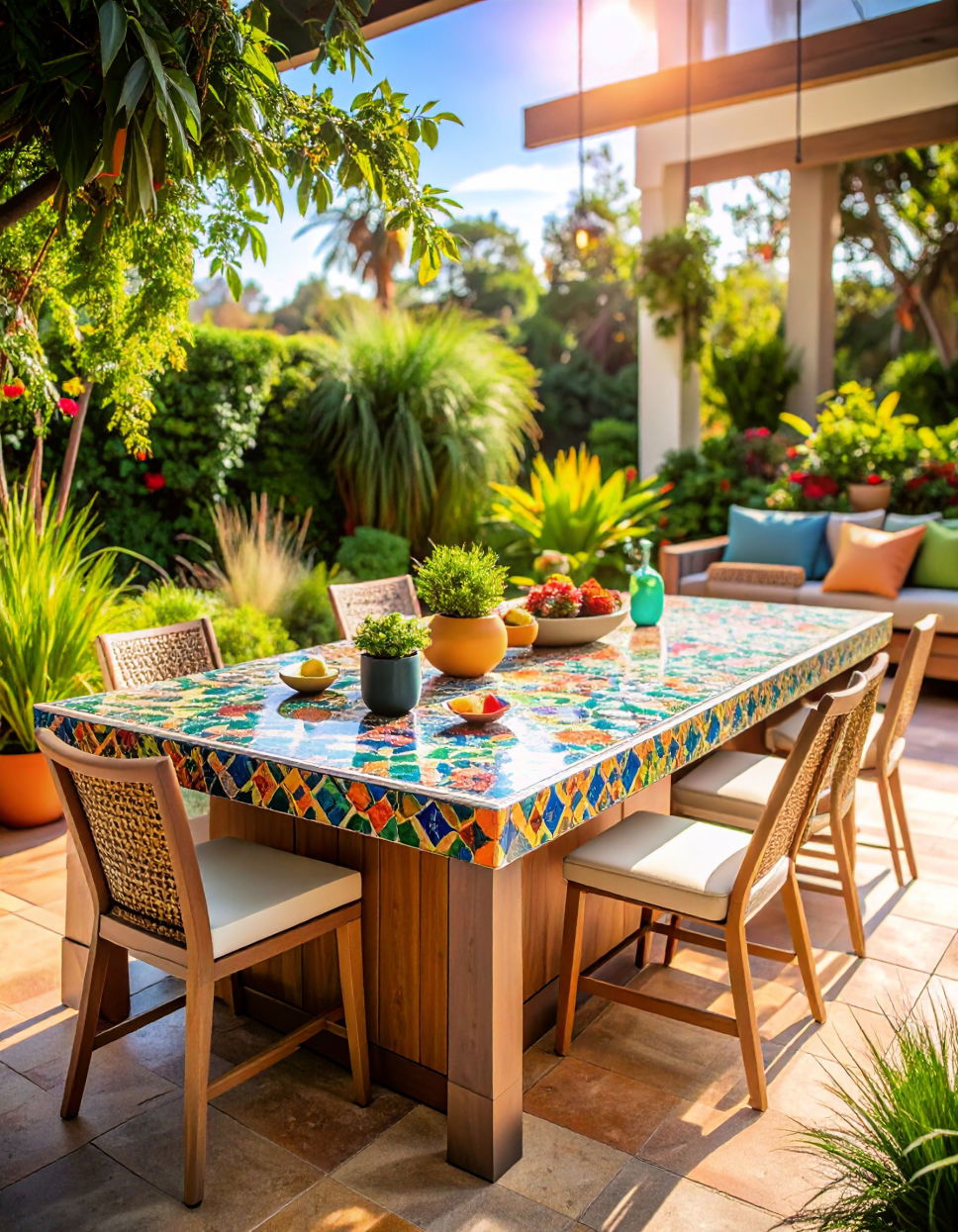
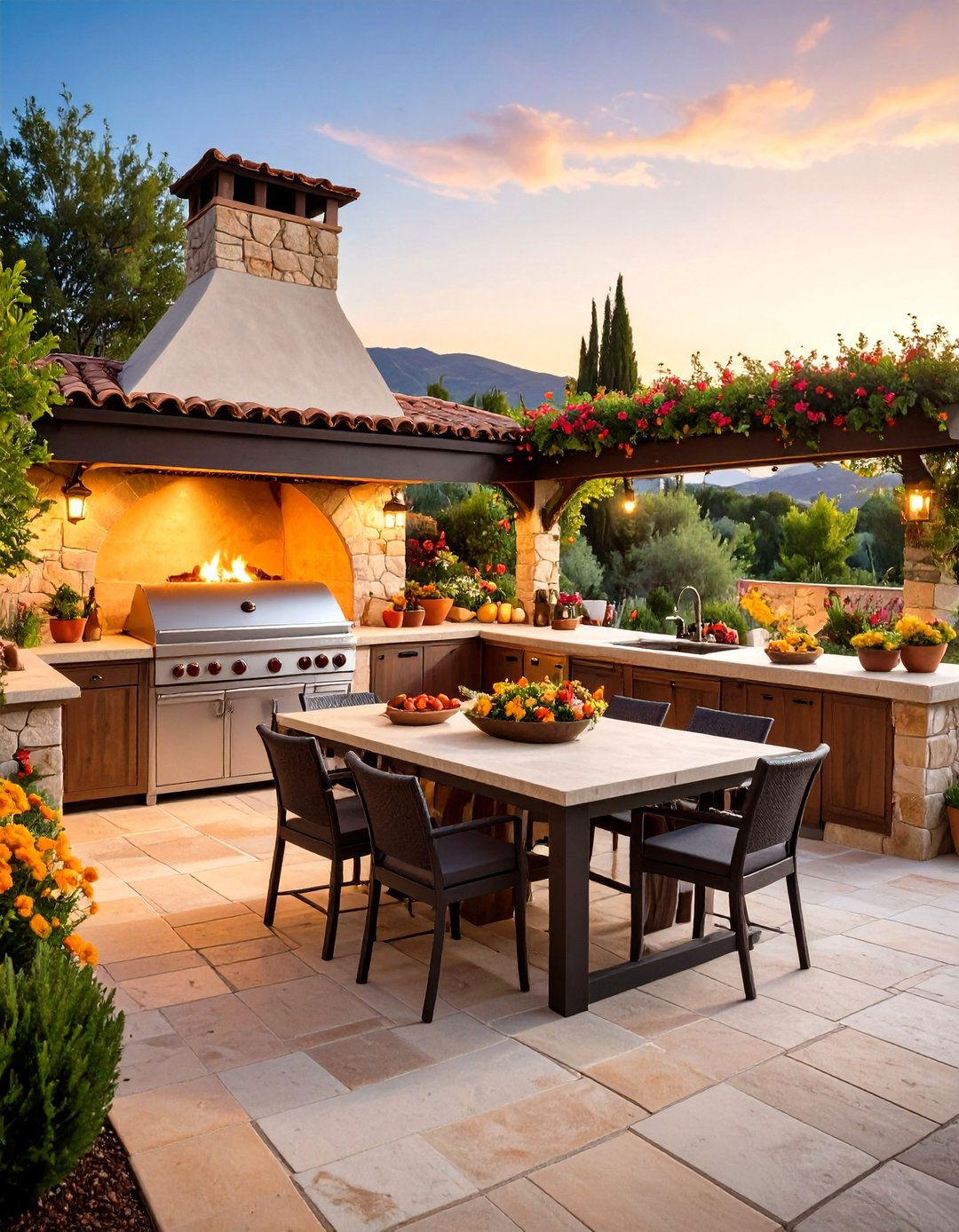
Leave a Reply